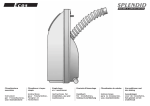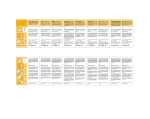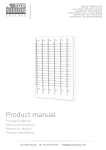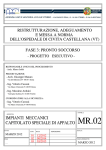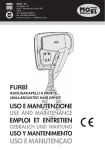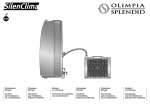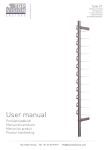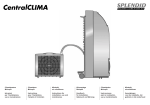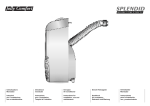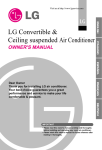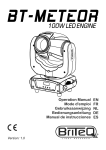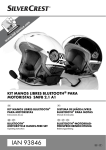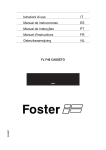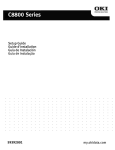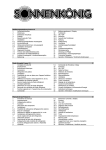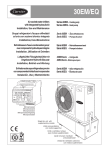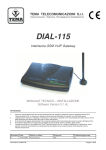Download Climatizador Minisplit Instrucciones para la instalación, uso y
Transcript
Climatizzatore Minisplit Climatiseur Minisplit Minisplit air conditioner Minisplit Klimaanlage Climatizador Minisplit Minisplit airconditioner Istruzioni per l’installazione, uso e manutenzione Instructions pour l’installation, l’emploi et l’entretien Instructions for installation, use and maintenance Handbuch für Installation, Gebrauch und Wartung Instrucciones para la instalación, uso y mantenimiento Aanwijzingen voor de installatie, het gebruik en het onderhoud 2 INTRODUZIONE INTRODUCTION FOREWORD VORWORT INTRODUCCION VOORWOORD Vi ringraziamo per la fiducia Merci de la confiance que vous Congratulations. Of all the air Wir danken Ihnen für das En primer lugar queremos Wij danken u voor het che ci avete accordato con avez bien voulu nous accorder en conditioners you could have Vertrauen, das Sie uns durch den agradecerles la confianza vertrouwen om te kiezen voor l’acquisto del Vostro achetant votre climatiseur. Nous chosen, you chose our product. Kauf des Klimagerätes depositada en nosotros con la onze airconditioner. climatizzatore. Siamo certi che sommes certains que vous avez We know this is a good choice entgegengebracht haben. Wir sind compra de su acondicionador. Wij zijn ervan overtuigd dat u avete operato una scelta giusta fait le bon choix car vous avez because it has made you the sicher, daß Sie richtig gewählt Podemos afirmar sin lugar a de juiste keuze hebt gemaakt. perché siete entrati in possesso maintenant un des climatiseurs proud owner of one of the most haben, denn jetzt besitzen Sie dudas que han efectuado una U bent nu in het bezit van een di uno dei più moderni e raffinati les plus modernes et raffinés modern, newest design air eines der modernsten und elección acertada, ya que han zeer moderne en praktische climatizzatori presenti sul que le marche propose. Les conditioners available on the praktischsten Klimageräte, die der adquirido uno de los más airconditioner. Leest u deze mercato. Le istruzioni che instructions contenues dans ce market. The instructions in this Markt zu bieten hat. Lesen Sie die modernos y refinados acondicio- handleiding aandachtig door seguiranno, Vi permetteranno di manuel vous permettront booklet will help you take full folgenden Anleitungen durch, nadores de aire presentes en el alvorens het apparaat te sfruttare appieno le qualità del d’exploiter au mieux les qualités advantage of everything this bevor Sie das Gerät benutzen. mercado. Las instrucciones que gebruiken. Volgt u nauwkeurig Vostro apparecchio. Seguitele de votre appareil. Suivez-les machine can do. Read it carefully Beachten Sie alle Hinweise, damit siguen, les permitirán aprovechar de aanwijzigingen zodat u een quindi con molta attenzione attentivement et respectez and follow the instructions, Ihnen ein angenehmer, al máximo las cualidades del aangename koele zomer attenendoVi scrupolosamente scrupuleusement les indications especially the “CAUTIONS”. This komfortabler Sommer garantiert aparato. Les aconsejamos por lo tegemoet gaat met uw alle indicazioni e soprattutto alle et surtout les recommandations: way your summer will be much ist, den Sie für Ihr Wohlbefinden tanto respetarlas escrupulosamen- airconditioner. verdient haben. te como así también observar avvertenze in modo da vous aurez ainsi la garantie d’un more comfortable with the benefit garantirVi un’estate ricca del été riche du meilleur confort, of cool air from your new air atentamente las advertencias miglior comfort, indispensabile indispensable à votre bien-être. conditioner. dadas, garantizándose de este per il Vostro benessere. modo un verano rico del máximo confort, indispensable para su VERSIONE CON IONIZZATORE Nel climatizzatore d'aria dotato di ionizzatore, questi entra in funzione automaticamente all'accensione dell'apparecchiatura. L'aria fresca ionizzata immessa nel locale, Vi permetterà di raggiungere una maggiore concentrazione attenuando eventuali mal di testa e sonnolenza dovuti all'aria viziata. Questa sensazione di benessere, è dovuta al giusto apporto di ioni negativi che, agendo da catalizzatori, abbassano notevolmente la quantità di fumi e pulviscolo presenti nei locali chiusi. Benefici questi, che potrete godere tutto l'anno, poichè i climatizzatori OLIMPIA/ SPLENDID sono predisposti per escludere la funzione di raffrescamento e funzionare solo come ionizzatore. bienestar. 3 AVVERTENZE • Assicuratevi che, tende o altri oggetti, non ostruiscano il filtro di aspirazione dell’aria posto sullo schienale del climatizzatore. RECOMMANDATIONS • Assurez-vous que les rideaux ou tout autre objet ne bouchent pas le filtre d’aspiration de l’air placé au dos du climatiseur. • Collegare il climatizzatore esclusivamente a prese elettriche dotate di messa a terra. • Branchez le climatiseur uniquement à des prises avec raccordement à la terre. • Per garantire una buona efficienza del climatizzatore eseguite almeno una volta all’anno una pulizia interna rivolgendoVi ad un centro di assistenza. • Pour un fonctionnement optimal de votre climatiseur, il est important de faire nettoyer l’intérieur de l’appareil au moins une fois par an, par un centre d’assistance specialisé. • Non ostruite il flusso dell’aria nella unità esterna ponendola troppo vicino a muri o vetri. • Evitare di curvare o torcere eccessivamente il tubo di collegamento tra le due unità. • Il totale arresto del CLIMATIZZATORE, nonostante che vi sia la normale alimentazione elettrica, può essere dovuto all'intervento di una sicurezza interna che impedisce la fuoriuscita di acqua. Prima di chiamare il centro assistenza provate a drenare l'acqua contenuta nel CLIMATIZZATORE togliendo il tappo apposito (Fig. 1). Se l'inconveniente dovesse riverificarsi fate controllare il Vs. climatizzatore da un tecnico specializzato. • L'apparecchio non deve essere utilizzato in locali adibiti a lavanderie. • Allorchè si decida di non utilizzare più un apparecchio di questo tipo, si raccomanda di renderlo inoperante tagliando il cavo di alimentazione, dopo aver staccato la spina dalla presa di corrente. Si raccomanda inoltre di rendere innocue quelle parti dell’apparecchio suscettibili di costituire un pericolo, specialmente per i bambini che potrebbero servirsi dell’apparecchio fuori uso per i propri giochi. ATTENZIONE: Questo prodotto contiene sostanze che danneggiano l’ozono stratosferico; alla fine del suo utilizzo deve essere consegnato agli appositi centri di raccolta: chiedere informazioni ai Servizi di gestione della nettezza urbana del vostro comune. • Ne gênez pas debit de l’air de l’unité exterieure en la mettant trop pres de murs et vitres. • Evitez que les raccordements entre les deux unités soit tordu ou forme des coudes inutiles. • Si le CLIMATISEUR s’arrête complétement, malgré une alimentation électrique normale, ceci est peut être dû à l’activation d’une sécurité interne qui empêche l’eau de s’évacuer. Avant d’appeler le centre d’assistance, essayer de drainer l’eau contenue dans le CLIMATISEUR en enlevant le bouchon spécial (Fig. 1). Si l’inconvénient se reproduit, faites contrôler l’appareil par un technicien spécialisé. • L'appareil ne doit pas être utilisé dans les buanderies. • Si vous pensez ne jamais plus utiliser cet appareil, nous vous conseillons de le rendre inopérant en coupant le câble d’alimentation après avoir débranché la fiche de la prise de courant. De plus, nous vous recommandons de rendre inoffensives les parties de l’appareil susceptibles de constituer un danger, spécialement pour les enfants qui pourrait se servir de l’appareil pour leurs jeux. ATTENTION: Ce produit contient des substances nuisibles à la couche d’ozone. Une fois son utilisation achevée, il doit être déposé dans un centre de traitement des déchets. Renseignez-vous auprès des services compétents de votre commune. IMPORTANT NOTES • Make sure that curtains or other objects do not obstruct the air intake filter on the back of the air conditioner. • Only connect the air conditioner to electrical sockets that have an earth. • To guarantee efficient air conditioner operation, have the unit cleaned internally once a year by your authorized service centre. • Do not obstruct the air flow in the outside unit by placing it too close to walls or windows. • Do not bend or twist the connection hose between the two units excessively. • If the AIR CONDITIONER stops completely, even when the electrical supply is functioning normally, this could be due to the intervention of an internal safety device which impedes the outflow of water. Before calling the service centre, try draining the water from the unit by removing the air plug (Fig. 1). If the problem persists, have your air conditioner checked by a specialized technician. • Do not use this equipment in laundries. • When you decide to no longer use an appliance of this type, you are recommended to make it inoperative by cutting the power cable, after disconnecting the plug from the power socket. You are also recommended to make harmless the parts of the appliance likely to constitute a danger, especially for children who could use the appliance out of order for their games. WARNING: This product contains substances that damage the ozone layer. When no longer used, it must be sent to the specific collection centers. For further information, consult your local Waste Disposal Service. HINWEISE • Achtung, der Luftansaugfilter auf der Geräte-Rückseite darf nicht von Gardinen oder anderen Gegenständen verdeckt werden. ADVERTENCIAS • Controlar que cortinas u otros objetos no obstruyan el filtro de aspiración del aire, presente en el espaldar del acondicionador. B E L A N G R I J K E AANWIJZIGINGEN • Draag zorg voor een goede luchttoevoer aan zowel voor- als achterzijde van het apparaat. • Das Klimagerät nur an geerdete Steckdosen anschließen. • Conectar el acondicionador únicamente a tomas eléctricas provistas de conexión a tierra. • Sluit het apparaat alleen aan op geaarde stopcontacten. • Voraussetzung für die einwandfreie Funktion ist, daß Sie Ihr Gerät mindestens einmal jährlich vom Fachmann innen gründlich reinigen lassen. • Das Außengerät nicht zu nahe an Wände oder Fenster aufstellen, damit die Luftzirkulation nicht behindert wird. • Den Verbindungsschlauch der beiden Geräte nicht knicken oder verbiegen. Sollte das Klimagerät trotz regelmäßiger Stromversorgung nicht anlaufen, so kann eine interne Sicherung angesprochen haben, die den Wasserauslauf verhindert. Vor Inanspruchnahme des Kundendienstes versuchen, das im Gerät enthaltene Wasser durch Abnahme des Stöpsels (Fig. 1) auslaufen zu lassen. Sollte dieses Problem wiederholt eintreten, so ist das Gerät von einem Techniker zu prüfen. • Das Gerät darf nicht in den Räumen verwendet werden, die als Wäscherei dienen. • Ein Gerät dieser Art ist bei endgültiger Außerbetriebnahme durch des Netzaschlußkabels unbrauchbar zumachen. Es empfiehlt sich überdies, die gefährlichen Teile abzusichern, Kinder könnten mit dem abgestellten Gerät spielen. ACHTUNG: Dieses Produkt enthält Stoffe, die die Ozonschicht schädigen können. Nach Gebrauch muß es bei den speziellen Entsorgungsstellen abgegeben werden: Diesbezügliche Informationen erhalten Sie bei lhrem Stradtreinigungsamt. • Para garantizar un correcto funcionamiento del acondicionador, efectuar por lo menos una vez al año una limpieza de la parte interna, dirigiéndose para ello a un centro de servicio postventa. • No obstruir el flujo de aire en la unidad externa colocándola demasiado cerca de muros o vidrios. • Evitar curvar o torcer excesivamente el tubo de unión entre las dos unidades. • Si el ACONDICIONADOR se para completamente a pesar de la normal alimentación eléctrica, puede ser que ello se deba a la activación de una seguridad interna que impide la evacuación del agua. Antes de llamar al centro de asistencia, trate de vaciar el agua contenida en el ACONDICIONADOR quitando el tapón correspondiente (Fig. 1). Si el inconveniente se repitiera haga controlar su acondicionador por un técnico especializado. • Om de goede werking te garanderen dient u het apparaat jaarlijks door de erkende vakman te laten reinigen. • Draag zorg voor een ongestoorde luchttoevoer van de buitenunit. • Buig of verdraai verbindingsslang niet. de • Als de airconditioner stopt ondanks juiste stroomvoorziening kan dit veroorzaakt worden door een interne beveiliging die de condenswaterafvoer controleert. Voor de servicedienst te raadplegen kunt u zelf de ontluchtingsplug verwijderen zodat het water kan weglopen (fig 1). Als dit probleem zich herhaald, laat dan het apparaat controleren door de erkende vakman. • Het apparaat mag niet gebruikt worden in wasserijen. • El aparato no tiene que se utilizado en ambientes destinados a lavanderías. • Het apparaat mag alleen gebruikt worden in droge ruimtes (IP 20 protectie). • En caso de que se decida no utilizar más un aparato de este tipo se recomienda volverlo inactivo cortando el cable de la alimentación eléctrica después de haber quitado el enchufe de la toma de corriente. Se recomienda además volver inactivas aquellas partes del aparato susceptibles de constituir un peligro, especialmente para los niños que podrían utilizar el aparato fuera de uso para sus juegos. • Het apparaat mag niet gebruikt worden in ruimtes met gevaarlijke goederen, gassen of vloeistoffen. ATENCIÓN: Este producto contiene sustancias dañosas para el ozono estratosférico; al final de su utilización se debe entregar a los centros de recogida específicos: soliciten informaciones a los Servicios de gestión de la limpieza urbana de su municipio. WAARSCHUWING: Brand- en explosiegevaar. • Het apparaat opstellen op een vlakke ondergrond. • Als u het apparaat niet meer wilt gebruiken maak het dan onaansluitbaar door, nadat de stekker uit het stopcontact is gehaald, de kabel door te snijden. Draag zorg voor afscherming van gevaarlijke delen. Kinderen kunnen met het apparaat gaan spelen. 4 11 5 4 7 6 12 3 1 9 8 13 10 2 Fig. 1 IDENTIFICAZIONE DELLE PARTI 1 - Unità interna 2 - Unità esterna 3 - Linea flessibile di collegamento 4 - Pannello comandi per la selezione delle funzioni 5 - Pannello comandi per la regolazione della temperatura e per la programmazione della partenza 6 - Griglia uscita aria 7 - Filtro aria 8 - Sportello di copertura attacchi rapidi 9 - Tasto di accensione generale 10 - Tappo e raccordo per svuotamento completo dell'acqua di condensa 11 - Maniglia di trasporto 12 - Maniglia aggancio unità esterna 13 - Supporto per unità esterna. IDENTIFICATION DES PRINCIPALES PARTIES 1 - Unité intérieure 2 - Unité extérieure 3 - Raccord flexible de jonction 4 - Panneau des commandes pour la sélection des fonctions 5 - Panneau des commandes pour le réglage de la température et programmation de la mise en rote 6 - Grilles de sortie air 7 - Filtre à air 8 - Couvercle des prises rapides 9 - Touche d’allumage géneral 10 - Bouchon et raccord de vidange totale de l’eau de condensation 11 - Poignée de transport 12 - Poignée d’accrochage de l’unité extérieure 13 - Support pour l’unité extérieure. LIST OF MAIN COMPONENTS 1 - Inside unit 2 - Outside unit 3 - Connecting hose 4 - Function control panel 5 - Temperature control panel 6 - Front cooled air grille 7 - Air filter 8 - Cover for quick connections 9 - ON/OFF switch 10 - Moisture emptying tube and plug 11 - Carrying handle 12 - Outside unit attachment handle 13 - Support for outside unit. BESCHREIBUNG DER GERÄTETEILE 1 - Innengerät 2 - Außengerät 3 - Verbindungsschlauch 4 - Schaltblende mit Funktionstasten 5 - Schaltblende für die Temperaturwahl und Zeitschaltautomatik 6 - Gitterabdeckung Luftauslaß 7 - Luftfilter 8 - Abdeckblende Schnellverbinder 9 - Hauptschalter 10 - Ablaßstöpsel für Kondenswasser 11 - Tragegriff 12 - Verbindungsgriff für Außengerät 13 - Auflagebügel für Außengerät. IDENTIFICACION DE LAS PARTES 1 - Unidad interna 2 - Unidad externa 3 - Racor flexible de conexión 4 - Panel de control para la selección de las funciones 5 - Panel de control para la regulación temperatura y para la programación del arranque 6 - Rejilla salida aire 7 - Filtro aire 8 - Puerta de protección de conexiones rápidas 9 - Interruptor de encendido general 10 - Tapón y racor para la evacuación completa del agua de condensación 11 - Manilla de transporte 12 - Manilla de enganche de la unidad exterior 13 - Soporte para unidad exterior. ONDERDELENLIJST (Fig. 1) 1 - Binnenunit 2 - Buitenunit 3 - VerbindinWgsslang 4 - Bedieningspaneel functie 5 - Gekoelde lucht rooster 6 - instelling uitblaasrichting 7 - Luchtfilter 8 - Afdekplaat koppelingen 9 - Aan/uit schakelaar 10 - Afsluitdop condenswater 11 - Handgreep 12 - Beugel tbv buitenunit 13 - Ondersteuning tbv buitenunit. 5 Fig. 2 POSIZIONAMENTO ED INSTALLAZIONE POSIZIONAMENTO DEL CLIMATIZZATORE Per ottenere dal climatizzatore la massima efficacia di funzionamento é fondamentale posizionarlo in ambienti aventi caratteristiche adeguate alla sua potenzialità (superficie, irraggiamento solare, ecc...). In ogni caso Vi raccomandiamo di dotare l’ambiente di mezzi idonei (tapparelle, veneziane, ecc...) ad eliminare l’irraggiamento solare attraverso le vetrate e di tenere chiuse, quanto più possibile, porte e finestre. Il posizionamento del Vs. climatizzatore deve essere effettuato tenendo conto delle seguenti importanti indicazioni: la unità interna andrà posta con la parte posteriore sempre ad una distanza di almeno 20 cm da qualsiasi ostacolo (tende, pareti, ecc.) che possano impedire un buon passaggio dell’aria dalla griglia posteriore con filtro. Anche la griglia anteriore deve rimanere libera da qualsiasi ostacolo che possa impedire l’uscita dell’aria. L'unità esterna deve sempre essere collocata al di fuori del locale dove si trova il climatizzatore ad esempio, su un davanzale o su un balcone (Fig. 2). Per evitare grosse fuoriuscite di acqua é indispensabile che la “unità esterna”, rimanga appoggiata su di un piano (Fig. 3). MISE EN PLACE ET INSTALLATION MISE EN PLACE DU CLIMATISEUR Pour obtenir un fonctionnement optimal de votre climatiseur il est fondamental de l’installer dans des lo caux ayant des caractéristiques adaptées à la capacite de l’appareil (superficie, rayonnement solaire, etc.). Nous vous recommandons dans tous les cas de prévoir dans le local des solutions appropriées (stores ventilation, etc.) pour limiter le rayonnement solaire à travers les vitres, mais aussi de tenir les portes et les fenêtres le plus possible fermées. Choisissez la place de votre climatiseur en tenant compte des indications suivantes: la partie arrière de l’unité intérieure doit être toujours placée à au moins 20 cm de toute sorte d’obstacle (rideaux, parois etc.) pouvant empêcher un bon passage de l’air de la grille arrière avec filtre. Même la grille avant doit être libre, de façon à ce que l’air puisse sortir librement. Placez toujours l’unité extérieure hors du local où il y a le climatiseur, par exemple sur le rebord d’une fenêtre ou sur le balcon (Fig. 2). Pour éviter les grosses fuites d’eau il est indispensable de poser l’unité extérieure sur une surface plate (Fig. 3). Fig. 3 POSITIONING AND INSTALLING POSITIONING THE AIR CONDITIONER To get the best cooling performance from your air conditioner, it is important to match its cooling capacity with the characteristics of the area to be cooled (size, exposure to sunlight and so on). Where possible, the room should be fitted with blinds and ventilation systems to limit heating from sun exposure as much as possible. Windows and doors should also be kept closed where possible. When selecting where to place your air conditioner, bear in mind these pointers: The indoor unit should be positioned so that its back is at least 20 cm from any obstacle (curtain, wall, etc.) that could prevent good air flow through the rear intake grille and its filter. Nothing should obstruct the cooled air flow from the front grille. The outdoor unit, as its name implies, must be placed outside the room to be cooled. Good locations are: window sills, balconies and so on (Fig. 2). To prevent heavy water leakage, it is important that the outside unit is placed on a flat surface (Fig. 3). Fig. 4 AUFSTELLUNG UND ANSCHLUSS AUFSTELLUNG DES KLIMAGERÄTES Das Klimagerät funktioniert nur dann optimal, wenn die Raumverhältnisse (Raumgröße, Sonneneinstrahlung, usw. ...) seiner Kapazität angepaßt sind. Wir empfehlen auf jeden Fall entsprechende Vorkehrungen (Sonnenschutz, Belüftung, usw.) zu treffen, damit bei verglasten Wänden die Sonneneinstrahlung in Grenzen gehalten wird. Fenster und Türen sollten möglichst geschlossen bleiben. Bei der Aufstellung folgendes beachten: Damit die Luftzirkulation am rückwärtigen Gitter mit Filter nicht behindert wird, muß die Rückwand der inneren Einheit mindestens 20 cm von anderen Gegenständen (Gardinen, Wände, usw.) entfernt sein. Auch die vordere Gitterabdeckung muß frei zugänglich sein, damit die Luft ungehindert zirkulieren kann. Das Außengerät wird getrennt vom Innengerät außerhalb des Raumes aufgestellt, z. B. auf einem Balkon, Fensterbrett usw. (Fig. 2) Um erhebliche Wasserverluste zu vermeiden, das Außengerät auf einer stabilen Unterlage befestigen (Fig. 3). Fig. 5 COLOCACION E INSTALACION UBICACION DEL ACONDICIONADOR Para obtener la máxima eficacia de funcionamiento del acondicionador, resulta fundamental colocarlo en ambientes que posean características adecuadas a su potencialidad (superficie, irradiación solar, etc.). Aconsejamos dotar siempre el ambiente de los medios idóneos para limitar la irradiación solar a través de las superficies con vidrios y de mantener cerradas lo más posible, puertas y ventanas. La colocación de su acondicionador debe ser efectuada considerando las importantes indicaciones que siguen: la unidad interna deberá ser colocada con la parte pos-terior siempre a una distancia de por lo menos 20 cm de cualquier clase de obstáculo (cortinas, paredes, etc.) que pueda impedir un correcto fluir del aire por la rejilla posterior con filtro. También la rejilla delantera debe encontrarse libre de todo tipo de obstáculo que pueda impedir la salida del aire. La unidad esterna debe ser colocada siempre fuera del ambiente donde se encuentra el acondicionador, sobre un umbral o un balcón, por ejemplo (Fig. 2). Para evitar pérdidas importantes de agua resulta indispensable que la “unidad externa” se apoye sobre un plano (Fig. 3). OPSTELLING EN INSTALLATIE OPSTELLING Om een goede werking van het apparaat te garanderen is het belangrijk dat de koelcapaciteit overeenkomt met de warmtebelasting van het vertrek waar het apparaat staat opgesteld. Aangeraden wordt directe instraling van zonlicht in de ruimte te voorkomen. Ramen en deuren van vertrekken welke uitkomen op de te conditioneren ruimte dienen zoveel mogelijk gesloten te blijven. Het apparaat dient aan de achterzijde tenminste 20 cm vrij van andere voorwerpen te staan. De buitenunit moet buiten het vertrek, balkon of vensterbank, worden opgesteld (Fig. 2). Om wateroverlast te voorkomen het buitendeel vlak opstellen (Fig. 3). 6 Fig. 6 E' anche possibile agganciare l'unità esterna a parete con tasselli la cui estremità con il gancio dovrà essere introdotta nella fenditura predisposta nella parte posteriore della struttura dell'unità esterna (Fig. 4). Nei climi più caldi, per ottenere un migliore rendimento, consigliamo di tenere l’unità esterna con la sua parte posteriore distanziata di 10 cm da muri vetri o altro in modo da consentire un’ottimale flusso di aria (Fig. 5). Il tubo di collegamento tra le due unità dovrà essere fatto passare tra i due battenti della finestra, i quali, durante il funzionamento del climatizzatore dovranno essere chiusi il più possibile (Fig.6). Nel caso si voglia operare una installazione “semifissa” che consenta la chiusura completa dei battenti della finestra occorrerà praticare un foro rettangolare di dimensioni 40 mm di larghezza e 25 mm di altezza nello stipite. Questo foro può essere eseguito: nella parte fissa, nella parte mobile, o nella parte fissa e mobile del serramento (Fig. 7). Il est aussi possible d’accrocher l’unité extérieure au mur à l’aide de chevilles dont l’extrémité portant le crochet devra être introduite dans les fentes prévues sur le dos de la structure de l’unité extérieure (Fig. 4). Dans le cas de climats très chauds pour obtenir un meilleur rendement nous conseillons de tenir le dos de l’unité exterieure au moins à 10 cm des murs, vitres ou autres pour faciliter le passage de l’air (Fig. 5). Le tuyau de raccordement entre les deux unités devra passer entre les deux battants de la fenêtre qui, pendant le fonctionnement du climatiseur, devront être fermés le plus possible (Fig. 6). Si vous voulez realiser une installation “demifixe” permeffant la fermeture totale des battants de la fenêtre, il faudra percer, dans le montant, un trou rectangulaire de 40 mm de large de haut 25 mm. Ce trou pourra être percé: seulement sur le bâti dormant ou seulement sur le châssis mobile, ou bien dans la partie fixe et mobile du cadre (Fig. 7). Fig. 7 “It may also be hung on the wall by means of expanding hook bolts. These hooks should fit into the slots on the back of the outdoor unit to position it correctly. (Fig. 4).” In very hot climates, for better cooling performance it is good practice to place the outdoor unit so that it is about 10 cm from the wall, window or other surface. This will optimize air flow (Fig. 5). The hose connecting the two units goes under the two partially closed wings of the window. When the unit is running, the wings should be kept closed as much as possible (Fig. 6). If you want a "semi-permanent" installation to allow you to close the window completely, cut a 40x25 mm rectangular hole in the window sill or frame (Fig. 7). Drill this hole either in the fixed part or in the moving part, or in the fixed and moving part of the window frame. Man kann das Außengerät auch mit zwei Dübeln an der Wand befestigen, wobei die Dübelhaken in die Wandbefestigungslöcher der Rückwand eingehakt werden (Fig. 4). Um die Kühlleistung in wärmeren Klimazonen zu steigern, empfehlen wir, zwischen Rückwand und Mauer, Fenster, u.a., einen Abstand von 10 cm einzuhalten, damit die Luft frei zirkulieren kann (Fig. 5). Der Verbindungsschlauch der beiden Geräte wird zwischen den beiden offenen Fensterflügeln nach außen geführt. Das Fenster soll soweit wie möglich geschlossen bleiben (Fig. 6). Sollten Sie eine “halbfeste” Aufstellung wählen, bei der das Fenster ganz zu ist, müssen Sie eine 40 mm breite und 25 mm hohe Öffnung in den Fensterrahmen bohren. Für die Öffnung kann man folgende Positionen (Fig. 7) wähien: a) am festen Rahmen b) am Flügel c) am Fensterrahmen und am Fügel. Es posible asimismo colgar la unidad externa a un muro mediante dos tarugos; los mismos presentan una parte provista de un gancho, el cual debe ser introducido en los oportunos asientos presentes en la parte posterior de la estructura de la unidad externa (Fig. 4). En climas excesivamente cálidos, para obtener un rendimiento mejor aconsejamos colocar la unidad externa con su parte posterior a una distancia de 10 cm de las paredes, vidrios etc., de modo al que se verifique un perfecto flujo de aire (Fig. 5). El tubo de conexión entre las dos unidades deberá pasar entre las dos hojas de la ventana, las que, durante la marcha del acondicionador, deberán permanecer cerradas lo más posible (Fig. 6). Si se desea realizar una instalación “semifija” que permita el cierre total de las hojas de la ventana, será necesario efectuar un orificio rectangular en el marco de 40 mm de anchura por 25 mm de altura. Dicho orificio puede ser realizado sólo en la parte fija, sólo en la parte móvil o bien sobre ambas partes (fija y móvil) del cerramiento (Fig. 7). De buiteunit kan worden opgehangen middels de twee haken uit de installatie kit (Fig. 4). In zeer hete klimaatgebeiden de buitenunit 10 cm vrijhangen om een betere luchtstroming te bewerkstelligen (Fig. 5). De verbindingsslang via het raam naar buiten leiden. Zorg dat het raam zover mogelijk gesloten blijft (Fig. 6). Voor een “semi-permanente” installatie: maak een gat van 40x25 mm in het kozijn zodat het raam gesloten kan blijven (Fig. 7). 7 Fig. 8 Fig. 9 AVVERTENZA: L'UNITA’ ESTERNA NON DOVRA’ MAI RESTARE APPESA PER IL SOLO TUBO DI COLLEGAMENTO. IMPORTANT: L’UNITE EXTERIEURE NE DEVRA JAMAIS RESTER ACCROCHEE PAR LE SEUL TUYAU DE RACCORDEMENT. CAUTION: NEVER HANG THE OUTDOOR UNIT BY THE CONNECTING HOSE WITHOUT OTHER SUPPORTS. HINWEISE: DAS GEWICHT DES AUSSENGERÄTES DARF NIEMALS NUR AM VERBINDUNGSSCH-LAUCH HÄNGEN. ADVERTENCIA: LA UNIDAD EXTERNA NO DEBE QUEDAR COLGADA JAMAS SOLAMENTE POR EL TUBO DE CONEXION. - AGGANCIO E SPOSTAMENTO DEL CLIMATIZZATORE Durante gli spostamenti le due unità interna ed esterna, possono essere agganciate tra loro. Per effettuare questa operazione é necessario appoggiare la “UNITA’ ESTERNA” sul supporto metallico inferiore in modo che le protuberanze presenti sulla base vadano ad incastrarsi fra i tubolari del supporto stesso. Una volta appoggiata la valigetta, per completare il fissaggio é necessario agganciare la maniglia intermedia nella apposita nicchia presente sulla “VALIGETTA ESTERNA” (Fig. 8). Tramite le sue ruote piroettanti, il climatizzatore può essere spostato da un’ambiente ad un’altro. E’ anche possibile trasportare il climatizzatore tirandolo tramite la maniglia posteriore (Fig. 9). Prima di effettuare questa operazione, scaricate l’acqua contenuta nell’unità esterna piegando la stessa su di un lato. - ACCROCHAGE ET DEPLACEMENT DU CLIMATISEUR Lors des déplacements les deux unités (intérieure et extérieure) ne peuvent pas être séparées. Pour effectuer cette opération il faudra poser “I’UNITE EXTERIEURE” sur le support métallique inférieur de manière à ce que les éléments en saillie de la base s’encastrent entre les tubulaires du support même. Après avoir appuyé le coffret, pour compléter sa fixation il est nécessaire d’accrocher la poignée intermédiarie dans le fente du “COFFRET EXTERIEUR” (Fig. 8). Grâce à ses deux roues pivotantes, le climatiseur peut être déplacé aisément d’un local à un autre. Il est également possible de le transporter en utilisant uniquement les deux roues arrière fixes (Fig. 9). Avant d’effectuer cette opération, vidanger l’eau contenue dans l’unité extérieure en l’inclinant sur un côté. - HOOKING THE TWO SECTIONS TOGETHER TO MOVE THE AIR CONDITIONER When moving the air conditioner, the two units can be hooked together as follows: - place the "OUTSIDE UNIT" on the lower metal support frame so that the protrusions on the base slip into the support frame. The final step is to secure the outdoor section to the attaching handle (Fig. 8). The "CLIMA" is fitted with castors and can be easily moved from room to room as needed. Move the air conditioner by tilting it back on the rear fixed position wheel (Fig. 9). Before doing this, empty out any water in the outdoor unit by tipping it to one side. - ANKUPPELN DER BEIDEN GERÄTE UND TRANSPORT Die beiden Geräte können aus Transportgründen miteinander verbunden werden. Dazu das Außengerät so auf den Auflagebügel abstellen, daß die Ausladungen der Bodenplatte auf dem Bügel einrasten. Für die Befestigung den Verbindungsgriff auf dem Gehäuse in die Vertiefung des Außengerätes (Fig. 8) einhaken. Das Klimagerät kann mit Hilfe seiner Rüder leicht und einfach von einem Raum in den anderen geschoben werden. Ebenso kann das Klimagerät mit den rückwärtigen fixen Rädern (Fig. 9) transportiert werden. Vor dem Transport das Wasser aus dem Außengerät ablassen, indem man dieses einfach zur Seite neigt. - ENGANCHE Y DESPLAZAMIENTO DEL ACONDICIONADOR Durante los desplazamientos las dos unidades, interna y externa, pueden ser enganchadas entre sí. Para efectuar esta operación resulta necesario apoyar la “UNIDAD EXTERNA “ sobre el soporte metálico inferior de modo tal que las protuberancias presentes en la base se encastren entre las partes tubulares del soporte mismo. Una vez apoyada la maleta para completar la fjación resulta necesario enganchar la manilla intermedia en el correspondiente asiento, presente en la “MALETA EXTERNA” (Fig. 8). Gracias a sus ruedas pivotantes el acondicionador puede ser desplazado de un ambiente a otro. Es posible asimismo trasladar el acondiconador tirándolo de la manilla trasera (Fig. 9). Es preciso descargar el agua contenida en la unidad externa, antes de efectuar el traslado, ladeando dicha unidad. BELANGRIJK: Laat de buitenunit niet alleen aan de verbindingsslang hangen. T R A N S P O R T : SAMENSTELLEN VAN BINNENEN BUITENUNIT Voor transport doeleinden kunnen de twee delen aan lekaar verbonden worden. Plaats de buitenunit op het metalen ondersteuningsframe en haak de beugel bovenaan vast (Fig. 8). De Clima kan nu eenvouding verplaatst worden. Zorg dat er geen water meer in de buitenunit staat (Fig. 9). 8 ALLACCIAMENTO ELETTRICO Prima di collegare il climatizzatore assicurarsi che: BRANCHEMENT ELECTRIQUE Avant de brancher le climatiseur assurezvous que: POWER SUPPLY Before connecting the air conditioner to the power supply, check: ELEKTRISCHER ANSCHLUSS Für den elektrischen Anschluß folgendes beachten: CONEXION ELECTRICA Antes de conectar el acondicionador verificar que: ELEKTRISCHE AANSLUITING Alvorens het apparaat aan te sluiten controleer: • La linea di alimentazione elettrica sia 220V - 240V/50Hz. • La ligne d’alimentation électrique soit de 220V - 240V/50 Hz. • that the mains supply is 220V 240V/50 Hz. • Anschluß nur an Wechselstrom 220V-240V/50Hz. • La línea de alimentación eléctrica sea de 220V - 240 V/50 Hz. • La linea di alimentazione sia dotata di messa a terra e dimensionata per una corrente di spunto di 20 A per evitare cali di tensione durante l’avvio del climatizzatore. • La ligne d’alimentation soit équipée de mise à la terre et dimensionnée pour un courant de 20 A pour éviter des baisses de tension pendant la mise en marche du climatiseur. • that the mains supply is 220-240V and that the supply line is properly earthed and sized for a pickup current of 20A, so as to avoid voltage drops when starting the air conditioner. • Die Steckdose muß geerdet und für Anlaufstrom von 20 A dimensioniert sein, damit beim Einschalten des Gerätes kein Spannungsabfall entsteht. • La línea de alimentación posea conexión a tierra y se encuentre preparada para una corriente de arranque de 20 A para evitar bajas de tensión durante la puesta en marcha del acondicionador. • of de voeding 220-240V/50 Hz is, goed geaard en voldoende afgezekerd voor 20A aanloopstroom om spanningsdips te voorkomen. • La presa abbia una portata di almeno 10 A a 250V qualora non fosse compatibile con la spina del condizionatore se ne raccomanda la sostituzione con una a norme CEI. • La prise ait une capacité d’au moins l0 A à 250 V. Dans le cas où la fiche du climatiseur ne correspondrait pas à votre prise de courant, remplacez-la par une autre conforme aux normes CEE. • that the unit connected to a 13 amp socket by a 13 amp plug fitted with a 13 amp fuse. All of which should comply with british standards. • I 1200/1300 W assorbiti dal climatizzatore sommati agli assorbimenti degli altri elettrodomestici e dell’impianto di illuminazione non provochino l’intervento dell’interruttore magnetotermico del Vostro impianto elettrico. • I conduttori della eventuale prolunga elettrica abbia almeno 1,5 mm2 di sezione. ACCENSIONE DEL CLIMATIZZATORE Per accendere il climatizzatore é necessario inserire il tasto basculante luminoso posto sul retro della macchina nella posizione indicata in Fig. 1. Una volta inserito questo tasto, si accenderà automaticamente la ventilazione. Se non sentite attivarsi la stessa controllate che il tasto “programmazione” sia disinserito (led spento). • Les 1200/1300 W absorbés par le climatiseur additionnés aux absorptions des autres électroménagers et de l’installation d’éclairage ne doivent pas provoquer l’intervention du disjoncteur magnétothermique de votre installation électrique. • Les conducteurs de la rallonge électrique éventuelle doivent avoir une section d’au moins 1,5 mm2. ALLUMAGE DU CLIMATISEUR Pour allumer le climatiseur, il faut la touche lumieuse basculer derrière la machine, sur la position indiquée par la Fig. 1. Après quoi la ventilation se mettra en marche automatiquement. Dans le cas contraire vérifiez que la touche “programmation” soit bien désactivée (led éteinte). • that the air conditioner's power draw of 1200/1300 W plus the other electrical appliances and the lighting system will not trip the circuit breaker on your electrical line. • that the wires in any extension cord used have a square section of at least 1,5 mm2. As the coulours of the wires in the mains lead of this appliance may not correspond with the coloured markings identifying the terminals in your plug, proceed as follows: The wire that is coloured green - and - yellow must be connected to the terminal in the plug which is marked with the letter E or by the earth symbol or coloured green or green - and - yellow. The wire that is coloured blue must be connected to the terminal that is marked with the letter N or coloured black. The wire that is coloured brown must be connected to the terminal that is marked with the letter L or coloured red. SWITCHING THE AIR CONDITIONER ON To turn your air conditoner on, set the lighted toggle switch on the back of the unit as shown on Fig. 1. As soon as you do this the fan will turn on. If you do not hear the fan running, check if the Programmer button is on OFF (LED off). • Die Steckdose muß einen Anschlußwert von mindestens 16 A bei 250 V haben. Sollte die Steckdose mit dem Gerätestecker nicht übereinstimmen, diese durch eine den CEE Bestimmungen entsprechende ersetzen. • Das Klimagerät hat einen Anschlußwert von 1 kW. Achtung, wenn das Klimagerät gleichzeitig mit anderen Haushaltsgeräten eingeschaltet wird, kann der Überstromschutzschalter ausgelöst werden. • Bei Verwendung eines Verlängerungskabels muß der Drahtquerschnitt mindestens 1,5 mm2 betragen. EINSCHALTEN DES KLIMAGERÄTES Das Klimagerät wird mit dem Wippleuchtschalter auf der Geräterückseite (s. Fig. 1) eingeschaltet. Dabei wird das Gebläse automatisch miteingeschaltet. Sollten Sie das Ventilatorgeräusch nicht hören, müssen Sie prüfen, ob die ProgrammierTaste ausgeschaltet ist (LED aus). • La toma posea una capacidad de corriente de por lo menos 10 A a 250 V. En el caso que no resulte compatible con el enchufe del acondicionador, se anconseja la sustitución con otra acorde a las normas CEI. • Los 1200/1300 W absorbidos por el acondicionador, sumados a los consumos de otros electrodomésticos y de la instalación de iluminación no provoquen la intervención del interruptor magnetotérmico de su instalación eléctrica. • Los conductores de las eventuales prolongaciones eléctricas posean por lo menos 1,5 mm2 de sección. USO DEL ACONDICIONADOR Además de enfriar el aire del ambiente el acondicionador puede ser utilizado también para filtrar, calefaccionar (cuando se encuentra provisto de la resistencia eléctrica opcional) y deshumidificar el aire. ENCENDIDO DEL ACONDICIONADOR Para encender el acondicionador es preciso accionar la tecla basculante luminosa ubicada en la parte trasera de la máquina, en la posición indicada en la Fig. 1. Una vez activada la citada tecla se encenderá automáticamente la ventilación. Si no se advierte dicha activación, controlar que la tecla “programación” se encuentre desactivada led apagado). • of het stopcontact tenminste een continu belastbaarheid heeft van 10A bij 250V. • Het apparaat verbruikt 1200/ 1300 W. U dient ervoor zorg te dragen dat dit samen met andere stroomverbruikers in uw huis niet leidt tot het aanspreken van zekeringen. • Indien u het apparaat aansluit middels een verlengsnoer, controleer of de gebruikte kabel tenminste een doorsnede heeft van 1,5 mm2. INSCHAKELEN VAN DE AIRCONDITIONER U schakelt het apparaat in door knop (9) op de achterzijde in te drukken, zie figuur 1. De ventilator dient nu te starten. Indien dit niet gebeurt druk dan op de toets voor het starten van de timerinstelling (11) figuur 10, het lampje dient uit te zijn. 9 Fig. 10 PANNELLI COMANDI Il climatizzatore è dotato di un sistema elettronico di selezione delle funzioni rappresentato nelle sue parti di comando nella Fig. 10 PANNEAU DES COMMANDES Le climatiseur est équipé d’un système électronique de sélection des fonctions représenté avec les organes de commande sur la Fig. 10. 1 - Display luminoso 2 - Tasto di impostazione start/stop programmazione 3 - Tasto di "incremento" ore di programmazione 4 - Tasto di "decremento" ore di programmazione 5 - Tasto di "incremento" valore di temperatura desiderata 6 - Tasto di "decremento" valore di temperatura desiderata 7 - Tasto di selezione 1a velocità di ventilazione 8 - Tasto per la selezione della 2a velocità e del modo "automatico" di regolazione della velocità di ventilazione 9 - Tasto di raffreddamento 10 - Tasto di riscaldamento (con resistenze optional) 11 - Tasto di inserimento del programmatore. 1 - Afficheur lumineux 2 - Touche de sélection start/stop programmation 3 - Touche croissante heures de programmation 4 - Touche de décroissante heures de programmation 5 - Touche croissante de la température desirée 6 - Touche de décroissante de la température désirée 7 - Touche de sélection 1e vitesse de ventilation 8 - Touche de sélection 2e vitesse de ventilation et du mode “automatique” de réglage de la vitesse de ventilation 9 - Touche de refroidissement 10 - Touche de chauffage (résistance en option) 11 - Touche d’activation du programmateur. CONTROL PANEL 1 - Lighted display 2 - Start/stop programming key 3 - Time forward key 4 - Time back key 5 - Temperature increase key 6 - Temperature decrease key 7 - Fan high speed select key 8 - Fan low speed select key and "Automatic" fan speed select 9 - Cooling select key 10 - Heating select key (if optional heating elements installed) 11 - Programmer on/off key. BEDIENBLENDE Das Klimagerät ist mit einem elektronischen System für die Auswahl der Funktionen ausgestattet. Die Funktionstasten sind in Fig. 10 zu sehen: 1 - Leuchtdisplay 2 - Ein/Aus - Programmierung Zeitschaltautomatik 3 - Taste zum Erhöhen der programmierten Stunden 4 - Taste zum Verringern der programmierten Stunden 5 - Taste für eine höhere Solltemperatur 6 - Taste für eine niedrigere Solltemperatur 7 - Taste für Ventilatorstufe 1 8 - Taste für Ventilatorstufe 2 und Automatik der Gebläsegeschwindigkeit 9 - Taste für Kühlbetrieb 10 - Taste für Heizbetrieb (mit Heizwiderstand als Sonderausstattung) 11 - Start - Taste Zeitschaltautomatik. PANEL DE CONTROL El acondicionador se encuentra provisto de un sistema electrónico de selección de las funciones, representado en las partes relativas al control en la Fig. 10: 1 - Display luminoso 2 - Tecla de fijación start/stop programación 3 - Tecla de “incremento” horas de programación 4 - Tecla de “decremento” horas de programación 5 - Tecla de “incremento” valor de temperatura deseado 6 - Tecla de “decremento” valor de temperatura deseado 7 - Tecla de selección 1a velocidad de ventilación 8 - Tecla para la selección de la 2a velocidad y del modo “automático de regulación de la velocidad de ventilación 9 - Tecla de refrigeración 10 - Tecla de calefacción (con resistencia opcional) 11 - Tecla de activación programador. BEDIENINGSPANEEL De airconditioner is uitgevoerd met een elektronisch functiekeuze systeem, zie figuur 10. 1 Verlichte aanduiding temperatuurinstelling 2 - Start/stop programmeren timer instellingen 3 Verhogen tijdsduur timerinstelling 4 - Verlagen tijdsduur timerinstelling 5 - Verhogen temperatuur instelling 6 - Verlagen temperatuur instelling 7 - Ventilatorsnelheid hoog 8 - Ventilatorsnelheid laag en "automatisch" 9 - Koelen aan/uit 10 - Verwarmen aan/uit (optie) 11 - Programeren aan/uit. 10 SELEZIONE FUNZIONI - ACCENSIONE GENERALE Premere il tasto basculante luminoso. Contemporaneamente si attiva la ventilazione che può venire selezionata alla 1ª o 2ª velocità agendo sugli appositi tasti. CHOIX DES FONCTIONS - ALLUMAGE GENERAL Appuyer sur la touche lumineuse à bascule. Activer en même temps la ventilation en effectuant la sélection de 1° le ou de la 2° vitesse au moyen des touches respectives. - REGOLAZIONE DEL TERMOSTATO (temperatura) Una volta acceso il climatizzatore mediante il tasto basculante posteriore comparirà sul display del pannello comandi l'indicazione della temperatura impostata (che può differire nella maggior parte delle situazioni da quella esistente in ambiente). Per impostare un nuovo valore si dovrà agire sui tasti (5) o (6) a secondo che si voglia incrementare o decrementare. Onde evitare maggiori logorii dei componenti interni del climatizzatore è consigliabile regolare il termostato prima di selezionare la funzione di climatizzazione voluta (raffreddamento o riscaldamento). - REGLAGE DU THERMOSTAT (température) Après avoir allumé le climatiseur au moyen de la touche à bascule arrière, l’indication de la température choisie (différente dans la plupart des cas de la température ambiante) apparaît sur l’afficheur du panneau des commandes. Pour programmer une nouvelle valeur il faudra utiliser les touches (5) ou (6), si vous voulez respectivement augmenter ou diminuer la température. Pour éviter d’abîmer les organes internes du climatiseur, réglez le thermostat avant de sélectionner la fonction de climatisation voulue (refroidissement ou chauffage). - RAFFREDDAMENTO Premete il tasto basculante luminoso di accensione generale posto nel retro delle macchina, regolate il termostato sul valore di temperatura da Voi desiderato. Selezionate la velocità, 1a o 2a, o il sistema automatico di regolazione della velocità di ventilazione, azionate il tasto di raffreddamento (9). AVVERTENZA: LA LOGICA ELETTRONICA DEL CLIMATIZZATORE É STATA PROGRAMMATA PER IMPEDIRE DANNEGGIAMENTI AL COMPRESSORE FRIGORIFERO. PERTANTO QUESTO NON RIPARTIRÀ PRIMA CHE SIANO PASSATI 3 MINUTI DAL SUO SPEGNIMENTO. - RISCALDAMENTO (OPTIONAL) Premete il tasto basculante luminoso regolate il termostato. Selezionate il tipo di ventilazione desiderata, premete il tasto di riscaldamento (10). - FUNZIONE DI VENTILAZIONE AUTOMATICA "AUTO" Per selezionare premere due volte il tasto della 2a velocità di ventilazione (8). La funzione è segnalata dall'accensione contemporanea dei due led - REFROIDISSEMENT Appuyez sur la touche lumineuse à bascule d’allumage général, située derrière la machine; réglez le thermostat sur la valeur de température désirée. Sélectionnez 1° le ou la 2° vitesse, ou le système automatique de réglage de la vitesse de ventilation, appuyez sur la touche de refroidissement (9). ATTENTION: LA LOGIQUE ELECTRONIQUE DU CLIMATISEUR A ETE PROGRAMMEE POUR EVITER D’ENDOMMAGER LE COMPRESSEUR FRIGORIFIQUE, POUR CETTE RAISON, IL NE SE REMETTRA EN MARCHE QUE TROIS MINUTES APRES SON ARRET. - CHAUFFAGE (OPTION) Appuyez sur la touche lumineuse à bascule et réglez le thermostat. Sélectionnez le type de ventilation désirée et appuyez sur la touche de chauffage (10). - VENTILATION AUTOMATIQUE “AUTO” Pour sélectionner ceffe fonction, appuyez deux fois sur la touche de la 2e vitesse de ventilation (8). Le fonctionnement automatique est signalé par l’allumage simultané des deux leds vertes de sélection des vitesses de SELECTING AIR CONTIONER FUNCTION - STARTING THE UNIT Press the lighted toggle switch.Select Low or High fan speed by means of the special keys. FUNKTIONSAUSWAHL EINSCHALTEN DES KLIMAGERÄTES Den Wippleuchtschalter drücken. Den Ventilator mit den entsprechenden Tasten auf die Schaltstufe 1 oder 2 stellen. - REGULATING THE THERMOSTAT (temperature) As soon as the air conditioner has been switched on from the toggle switch at the rear, the display on the control panel will show the temperature set (this will usually be different from the actual room temperature). Use keys 5 and 6 to increase or decrease. To prevent unnecessary strain on the internal components it is good practice to set the temperature before selecting the operational mode (cooling or heating). - EINSTELLUNG DES THERMOSTATEN (Temperatur) Nach Einschalten des Klimagerätes mit dem Leuchtkippschalter erscheint auf dem Display der Bedienblende die Angabe der eingestellten Temperatur (die in den meisten Fällen nicht mit der Raumtemperatur übereinstimmt). Um einen neuen Wert einzustellen, die Tasten (5) oder (6) drücken, je nachdem ob die Temperatur erhöht oder gesenkt werden soll. Um einen vorzeitigen Verschleiß der inneren Komponenten des Klimagerätes zu vermeiden, sollte der Thermostat eingestellt werden, bevor man die gewünschte Gerätefunktion einschaltet (d.h. Kühlbzw Heizbetrieb). - COOLING Press the on-off lighted toggle switch on the back of the air conditioner. Set the thermostat to the temperature you want. Set the fan speed on Low or High or on automatic fan speed. Press the Cooling key (9). IMPORTANT: THE AIR CONDITIONER'S ELECTRONIC LOGIC HAS BEEN PROGRAMMED TO PREVENT DAMAGE TO THE COMPRESSOR. THEREFORE IF THE UNIT IS SWITCHED OFF THE COMPRESSOR WILL NOT RE-START UNTIL 3 MINUTES HAVE ELAPSED FROM WHEN IT WAS SWITCHED OFF. - HEATING (OPTIONAL) Press the lighted toggle switch and set the thermostat. Select fan speed and hit the HEATING key (10). - AUTOMATIC FAN CONTROL MODE "AUTO" To select this mode press the Low fan speed key (8) twice. Both fan speed green LEDS will light at the same time to show that this function has been activated. In this mode fan speed is automatically regulated according to the difference between outside temperature and inside temperature set. When this difference is more than 2 degrees the fan will run at high speed. When the difference is less than 2 degrees Celsius, low fan speed will be automatically set. Automatic fan speed mode can be set during cooling or heating. - KÜHLBETRIEB Den Wippleuchtschalter drücken, der auf der Geräterückseite angeordnet ist. Den Thermostaten auf den gewünschten Wert einstellen. Den Ventilator auf Stufe 1 oder 2 oder auf die Automatik stellen. Mit Taste (9) die Kühlfuntion wählen. HINWEIS: DIE ELEKTRONIK DES KLIMAGERÄTES IST SO PROGRAMMIERT, DASS EINE BESCHÄDIGUNG DES KÜHLKOMPRESSORS VERMIEDEN WIRD. DIESER LÄUFT NACH EINER UNTERBRECHUNG DAHER ERST MIT EINER PAUSE VON 3 MINUTEN WIEDER AN. - HEIZBETRIEB (SONDERAUSSTATTUNG) Den Wippleuchtschalter drücken und den Thermostaten einstellen. Die gewünschte Ventilationsstufe einschalten und dann Taste (10) drüchen. - AUTOMATISCHE VENTILATION “AUTO” Um die Gebläseautomatik einzuschalten, zweimal die Taste der Ventilatorstufe 2 drücken (8). Diese Betriebsart wird durch das gleichzeitige Aufleuchten der beiden grünen LED's angezeigt, die den Tasten zur Auswahl der Gebläsegeschwindigkeit entsprechen. Bei dieser Funktion wird ELECCION FUNCIONES - ENCENDIDO GENERAL Pulsar la tecla basculante luminosa. Simultáneamente se activa la ventilación, que puede ser seleccionada en la 1a ó 2a velocidad utilizando las respectivas teclas. FUNCTIEKEUZE - INSCHAKELEN VAN HET APPARAAT Druk op knop 9, figuur 1, op de achterzijde van het apparaat. De ventilator zal gaan draaien op het ingestelde toerental. - REGULACION DEL TERMOSTATO (temperatura) Una vez que hemos encendido el acondicionador mediante la tecla bas-culante posterior aparecerá en el display del panel de control la indicación de la temperatura fijada (que puede diferir, en la mayoría de los casos, de la temperatura ambiente). Para fijar un nuevo valor deberemos utilizar las tecla (5) ó (6), según esto comporte un aumento o bien una disminución. Para evitar mayores desgastes de los componentes internos del acondicionador aconsejamos regular el termostato antes se seleccionar la función de climatización deseada (refrigeración o calefacción). INSTELLEN VAN DE THERMOSTAAT Na het inschakelen zal de actuele temperatuurinstelling worden weergegeven. Stel nu de gewenste temperatuur in middels toetsen (5) en (6) op het bedieningspaneel, figuur 10. Om onnodig schakelen van het apparaat te voorkomen is het wenselijk de temperatuur in te stellen alvorens “koelen” aan te zetten. - REFRIGERACION Pulsar la tecla basculante luminosa de encendido general situada en la parte posterior del aparato, regular el termostato en el valor de temperatura deseado. Seleccionar la velocidad la 1a ó 2a, o el sistema automático de regulación de la velocidad de ventílacíon; accionar la tecla de refrigeración (9). ADVERTENCIA : LA LOGICA ELECTRONICA DEL ACONDICIONADOR HA SIDO PROGRAMADA PARA PROTEGER DE EVENTUALES DAÑOS EL COMPRESOR FRIGORIFICO. ESTE, POR LO TANTO, NO SE VOLVERA A ACTIVAR HASTA QUE NO HAYAN PASADO 3 MINUTOS DESDE SU APAGADO. - CALEFACCION (OPCIONAL) Pulsar la tecla basculante; regular e termostato. Seleccionar el tipo de ventilación deseada; pulsar la tecla de calefacción (10). Durante el funcionamiento en calefacción las ventanas del local pueden permanecer cerradas, ya que no resulta necesario el posicionamiento externo de la valija, la que permanece inactiva durante la fase de calefacción. - KOELEN Schakel het apparaat aan. Stel de gewenste temperatuur in en druk op toets (9) van het bedieningspaneel, figuur 10. BELANGRIJK: De elektronische besturing zal beschadiging van de compressor voorkomen door na het uitschakelen van de compressor deze pas na 3 minuten weer in te schakelen. - VERWARMEN (optie) Schakel het apparaat aan. Stel de gewenste temperatuur in en druk op toets (10), figuur 10. - A U T O M A T I S C H E VENTILATORSNELHEID Voor automatische regeling van de ventilatorsnelheid drukt u 2 maal op toets (8), figuur 10. Beide groene LED’s zullen oplichten. In deze “auto” stand zal de ventilator automatisch de hoge snelheid kiezen indien de ruimtetemperatuur meer dan 2°C hoger is dan de ingestelde temperatuur. Indien dit verschil weer kleiner wordt dan 2°C, schakelt het apparaat automatisch terug naar de lage ventilatorsnelheid. Auto stand is mogelijk in zowel koelen als verwarmen (optie). 11 verdi corrispondenti ai tasti di selezione delle velocità di ventilazione. Questo modo di funzionamento consente, una regolazione automatica della velocità di ventilazione in funzione della differenza esistente tra temperatura in ambiente e temperatura desiderata. In particolare quando la temperatura ambiente differisce per un valore superiore ai 2°C da quella impostata sul termostato del climatizzatore il ventilatore funzionerà alla massima velocità, per differenze inferiori ai 2° C la velocità di ventilazione diventerà automaticamente quella minima. La selezione di questa funzione può essere fatta sia durante il raffreddamento che il riscaldamento. PROGRAMMAZIONE Premendo il tasto n° 3 o il tasto n° 4 comparirà lampeggiando ad intermittenza sul display luminoso il valore corrispondente al numero di ore dopo le quali il climatizzatore si spegnerà o si accenderà. L'indicazione relativa alla prossima accensione o spegnimento (tempo massimo di programmazione di 99 ore) è data dal punto rosso posto nella parte alta del display che come evidenziato dalla simbologia, si troverà a destra quando l'apparecchio è programmato per l'accensione ed a sinistra quando lo è per lo spegnimento. Per variare la programmazione è sufficiente mediante i tasti (3) (4) impostare il numero di ore dopo le quali si desidera l'accensione o lo spegnimento dell'apparecchio. Tramite il tasto (2 ) si seleziona la partenza o l'arresto del cilmatizzatore dopo il numero di ore programmate. Per attivare la programmazione è necessario premere il tasto (11) sul pannello di destra. L'operazione è eseguibile solo quando sul display ricomparirà l'indicazione della temperatura impostata. L'avvenuto inserimento è segnalato da un led giallo lampeggiante a fianco del tasto. ESEMPIO: Supponiamo che siano le 8 del mattino e che vogliate fare accendere CLIMA alle 16.00. In questo caso dovrete agire nel modo seguente: accendete il climatizzatore tramite il tasto basculante, controllate che il tasto di programmazione (11) sia disinserito, selezionate ventilation. Vous obtiendrez ainsi le réglage automatique de la vitesse de ventilation en fonction de la différence qui existe entre la temperature ambiante et la température désirée. Plus precisément, quand la température ambiante dépasse de 2°C celle programmée sur le thermostat du climatiseur, le ventilateur fonctionnera à la vitesse maximale; pour des différences inférieures à 2° C, la vitesse sera automatiquement la plus basse. La sélection de cette fonction est possible aussi bien pendant le refroidissement que le chauffage. PROGRAMMATION En appuyant sur la touche n° 3 ou la touche n° 4, I’afficheur lumineux indiquera une valeur clignotante qui correspond au nombre d’heures après lesquelles le climatiseur va s’allumer ou s’éteindre. L’indication du prochain allumage ou arrêt (durée maximum de programmation: 99 h) est donnée par le point lumineux dans la partie haute de l’afficheur: comme indiqué par les symboles, ce point se trouve à droite quand l’appareil est programmé pour l’allumage et à gauche quand il doit s’éteindre. Pour changer la programmation il suffit d’introduire le nombre d’heures, au moyen des touches (3) (4), après les quelles vous voulez que votre climatiseur démarre ou s’arrête. Au moyen de la touche (2) sélectionnez la mise en marche ou l’arrêt du climatiseur après le nombre d’heures programmé. Pour activer la programmation appuyez sur la touche (11) prévue sur le panneau de droite. Cette opération est possible uniquement quand l’indication de la température choisie réapparaît sur l’afficheur. La bonne issue de la sélection est signalée par une led jaune clignotante à côté de la touche. EXEMPLE: On suppose qu’il est 8h00 et que vous voulez que le climatiseur démarre à 16h00. Il faudra procéder de la manière suivante: allumez le climatiseur au moyen de la touche à bascule, contrôlez que la touche de programmation (11) soit désactivée, sélectionnez la première ou la deuxième vitesse ou la ventilation automatique, réglez le thermostat et appuyez sur la touche de refroidissement. Ensuite sélectionnez le n°8 sur l’afficheur (8 heures) au moyen des touches (3) et (4), mettez le point rouge sur la position START au PROGRAMMING THE AIR CONDITIONER Press key 3 or 4 and the display will flash the period of time after which the conditioner will switch OFF or ON. The red dot at the top of the display will indicate the next ON or OFF operation (max programming time: 99 h). Note that when this red LED is on the right side, the air conditioner is programmed to switch ON. When it is on the left, the machine is programmed to switch OFF. To change these programme set points, use key 3 or 4 and set the number of hours after which you want the air conditioner to switch ON or OFF. Key 2 programmes air conditioner start up or switch off after the number of hours set. To activate programming, press key (11) on the right panel. This can only be done when the temperature setting is shown on the display. The yellow programme LED will begin to flash to signal that it has been activated. HERE IS AN EXAMPLE: Let's say it is 8:00 am and you want to turn on the air condtioner at 4:00 pm. Follow these steps: Switch on the air conditioner by the toggle switch. Check to make sure that the Programmer key (11) is OFF. Select High, Low or AUTO fan speed. Set the thermostat by pressing the COOLING key. Set 8 (8 hours) on the display using keys 3 or 4 and use key 2 to move the red cursor to START key. As soon as you press the programming key, the air conditioner will shut down any current operation and will begin the new programme once the eight hours have elapsed. die Geschwindigkeit des Ventilators automatisch geregelt, und zwar aufgrund des Unterschiedes zwischen der Raumtemperatur und der Solltemperatur. Bei Temperaturdifferenzen, die größer als 2 Grad sind, läuft der Ventilator auf der Höchstgeschwindigkeit. Wenn die Differenz sich verringert, schaltet das Gebläse automatisch auf die kleinere Stufe herab. Diese Funktion kann sowohl beim Heizen als auch beim Kühlen benutzt werden. PROGRAMMIERUNG Beim Drücken von Taste 3 oder 4 erscheint auf dem Display die blinkende Anzeige der Stunden, nach denen das Gerät ein-bzw. abgeschaltet wird. Die Anzeige zum bevorstehenden Ein- bzw. Abschalten des Gerätes wird durch einen roten Leuchtpunkt im oberen Displayteil gegeben. Dieser Punkt steht auf der rechten Seite unter dem entsprechenden Symbol, wenn es für die Einschaltautomatik, und auf der linken Seite wenn es für (maximale Programmierungszeit: 99 Stunden) die Abschaltautomatik programmiert ist. Zum Umprogrammieren nur die Taste (3) oder (4) drücken und die Stunden eingeben, nach denen das Gerät einbzw. abschalten soll. Mit Taste (2) wird das Anlaufen oder das Abstellen des Gerätes angewählt, nachdem die Anzahl der Stunden eingegeben worden ist. Um Zugriff zum Programmiervorgang zu bekommen, ist die Taste (11) rechts auf der Bedienblende zu drücken. Dieser Vorgang ist allerdings erst dann möglich, wenn die Anzeige der Solltemperatur wieder auf dem Display erscheint. Das erfolgte Einschalten wird durch das Aufblinken einer gelben LED neben der Taste angezeigt. BEISPIEL: Nehmen wir an, es ist 8 Uhr morgens und wir wollen, daß CLIMA sich um 16.00 automatisch einschaltet, damit die Räume angenehm kühl sind, wenn wir nach Hause kommen. In diesem Fall ist folgendermaßen vorzugehen: das Gerät mit dem Wippschalter einschalten. Prüfen, ob die Programmiertaste (11) ausgeschaltet ist. Die Geschwindigkeit des Ventilators auf Stufe 1 oder 2 oder auf Automatik stellen. Den Thermostaten einstellen. Die Taste für Kühlbetrieb drücken. Mit den Tasten (3) oder (4) auf dem Display die Ziffer 8 (8 Stunden) einstellen. Mit - VENTILACION AUTOMATICA “AUTO” Para la selección pulsar dos veces la tecla de la 2a velocidad de ventilación (8). La función se encuentra señalada mediante el encendido simultáneo de dos led verdes correspondientes a las teclas de selección de las velocidades de ventilación. Este sistema de funcionamiento permite una regulación automática de la velocidades de ventilación en función de la diferencia existente entre la temperatura ambiente y temperatura deseada. En modo especial cuando la temperatura ambiente difiere de más de 2° C respecto a la temperatura fijada en el termostato del acondicionador el ventilador funcionará a la máxima velocidad; con diferencias menores a 2° C la velocidad de ventilación pasará a ser automáticamente la mínima. La selección de esta función puede ser realizada tanto durante la refrigeración como durante la calefacción. PROGRAMACION Pulsando la tecla n° 3 o la tecla n° 4 en modo intermitente aparecerá en el display luminoso el valor correspondiente al número de horas luego de las cuales el acondicionador se apagará o se encenderá. La indicación relativa al próximo encendido o apagado (tiempo máximo de programación de 99 horas) está dada por el punto rojo situado en la parte alta del display, que como lo evidencia la simbologia, se encontrará a la derecha cuando el aparato se halla programado para el encendido y a la izquierda cuando está programado para el apagado. Para variar la programación basta fijar, mediante las teclas (3) (4), el numero de horas luego de las cuales se desea el encendido o apagado del aparato. Mediante la tecla (2) se selecciona la puesta en marcha o la detención del acondicionador transcurridas las horas programadas. Para activar la programación es necesario pulsar la tecla (11) en el panel de la derecha. La operación puede ser realizada solamente cuando reaparece en el display la indicación de la temperatura fijada. La efectiva activación se encuentra señalada mediante un led amarillo intermitente ubicado junto a la tecla. EJEMPLO: Supongamos que sean las 8 de la mañana y se desea el encendi- PROGRAMMEREN Alvorens de tijdinstelling te kunnen wijzigen dient u de tijdfunctie uit te schakelen met toets 11, fig.10. Het indicatielampje dient uit te zijn. Gebruik nu de toetsen 3 of 4, figuur 10, en het display zal de tijd aangeven waarna het apparaat zal starten danwel stoppen. Stel de tijd in. Indien de rode punt in het display rechtsboven staat is de unit geprogrammeerd om na de gegeven tijd te starten. Als de rode punt zich links bevindt is de unit geprogrammeerd te stoppen na de aangegeven tijdsduur. Gebruik toets 2, fig.10, om de start of stop tijd te programmeren. Om het tijdprogramma te activeren druk op toets 11, fig. 10. Het lampje dient nu aan te zijn. VOORBEELD: Het is ‘s morgens 08.00 uur en men wil 16.00 uur dezelfde dag het toestel in werking laten treden. Zet de Clima Aan. Zorg dat de programmeer functie uit staat (11) fig. 10. Kies de gewenste ventilatorsnelheid. Toets koelen "Aan". Durk nu op de "start" toets (vasthouden) totdat het cijfer 8 in het venster verschijnt (16.00-08.00=8). Zondra na het loslaten het cijfer niet mee knippert druk dan toets 11 in. De klok is nu ingesteld en het toestel zal na 8 uur, om 16.00 uur starten. Alle lopende functies worden onderbroken. 12 08 START-STOP Fig. 11 la prima o la seconda o il modo automatico di regolazione della velocità di ventilazione, regolate il termostato, premete il tasto di raffreddamento. Mediante i tasti (3) e (4) impostate il n° 8 sul display (8 ore), tramite il tasto (2) portate il punto rosso in posizione START. Appena il display avrà smesso di lampeggiare premete il tasto prog r a m m a z i o n e . Contemporaneamente all'azionamento del tasto di programmazione il Vs. climatizzatore interromperà le proprie funzioni riprendendole una volta trascorse le 8 ore impostate. TRASPORTO DEL CLIMATIZZATORE Deve avvenire di preferenza in posizione verticale. In caso di trasporto in posizione orizzontale lasciare trascorrere almeno un’ora prima di mettere in funzione il climatizzatore. Prima di effettuare il trasporto si consiglia di scaricare completamente l’acqua di condensa accumulatasi all’interno agendo sul tappo di svuotamento (fig. 1), svuotate anche la “unità esterna" inclinandola su di un lato. moyen de la touche (2). Dès que l’afficheur cesse de clignoter, appuyez sur la touche de programmation. En même temps que l’activation de cette dernière touche le climatiseur interrompt ses fonctions et il se remettra en marche a la fin des 8 heures programmées. TRANSPORT DU CLIMATISEUR Le transport du climatiseur doit être fait de préférence en position verticale. Si le transport en position horizontale est vraiment nécessaire, attendre au moins une heure avant d’allumer à nouveau l'appareil. Avant d’effectuer le transport du climatiseur il faut absolument vidanger l’eau de condensation qui s’est accumulée pendant le fonctionnement en enlevant le bouchon (Fig. 1); vidangez aussi l’unité extérieure en l’inclinant sur un côté. TRANSPORTING THE AIR CONDITIONER Ideally, the air conditioner should always be moved in an upright position. Wait at least an hour before using it after you have transported it. Before moving the unit, empty any water inside it by opening the drain plug (Fig. 1). Tilt the outdoor unit to empty this as well. ROUTINE MAINTENANCE Unplug the air conditioner from the power socket before any maintenance work. Taste (2) den roten Leuchtpunkt auf die Position START bringen. Sobald er zu blinken aufhört, die Programmiertaste drücken. Mit dem Betätigen der Programmiertaste unterbricht Ihr Klimagerät seinen Betrieb, um ihn in genau 8 Stunden später wieder aufzunehmen. TRANSPORT DES KLIMAGERÄTES Das Gerät wenn möglich in vertikaler Stellung transportieren. Nach einem Transport in horizontaler Stellung eine Stunde mit dem Einschalten warten. Nicht vergessen, das Kondenswasser vor jedem Transport vollständig abzulassen, indem man den Ablaßstöpsel (Fig. 1) öffnet. Das Außengerät auf die Seite neigen und entleeren. WARTUNG Vor Beginn aller Wartungsarbeiten immer den Netzstecker ziehen. do de acondicionador a las 16.00, en este caso será preciso operar del siguiente modo: encender el acondicionador mediante la tecla basculante, controlar que la tecla de programación (11) se encuentre desactivada, seleccionar la primera o la segunda velocidad de ventilación o el modo automático de regulación de la misma, regular el termostato, pulsar la tecla de refrigeración. Mediante las teclas (3) y (4) fijar el n° 8 en el display (8 horas), mediante la tecla (2) llevar el punto rojo a posición START. No bien cesa la intermitencia del display pulsar la tecla programación. Simultáneamente con, el accionamiento de la tecla de programación el acondicionador interrumpirá sus funciones, retomándolas una vez transcurridas las 8 horas programadas. TRASLADO DEL ACONDICIONADOR Debe verificarse preferiblemente en posición vertical. En caso de traslado en posición horizontal, dejar transcu-rrir por lo menos una hora antes de encenderlo. Antes de efectuar desplaziamientos es de fundamental importancia descargar completamente el agua de condensación presente en el interior del condicionador, utilizando para ello el tapón de evacuación (Fig. 1), vaciar además la “unidad externa” inclinándola hacia un lado. VERVOEREN VAN DE CLIMA Het apparaat dient zo mogelijk verticaal te worden vervoerd. Na vervoer altijd tenminste een uur wachten alvorens het apparaat te gebruiken. Indien transport liggend heeft plaats gevonden, het apparaat 24 uur niet aanzetten. Haal voor transport al het condenswater uit het apparaat en de buitenunit (Fig. 1). ONDERHOUD Haal alijd de stekker uit het stopcontact alvorens onderhoud te plegen. 13 Fig. 12 MANUTENZIONE PERIODICA Scollegare elettricamente il climatizzatore sfilando la spina dalla presa di corrente prima di eseguire qualsiasi operazione di manutenzione. PULIZIA DEI FILTRI DELL'ARIA Il filtro è preposto a trattenere molte delle impurità contenute nell'aria (polvere, pollini, batteri). Per questo motivo è necessaria una loro periodica pulizia. Questa operazione è consigliata almento una volta alla settimana. Per la rimozione del filtro è sufficiente afferrare il bordo superiore dello stesso ed alzandolo sino a quando non sarà completamente estratto dalla propria sede. (Fig. 12). La pulizia del filtro andrà fatta tramite un getto di acqua (doccino della vasca da bagno). Prima di riporre il filtro scuotete l'acqua in eccesso. PULIZIA DEL CLIMATIZZATORE Utilizzare per la pulizia esterna saponi o detergenti evitando l’uso di benzina, gasolio o prodotti affini. ENTRETIEN PERIODIQUE Déconnecter le climatiseur en débranchant la fiche de la prise de courant avant toute intervention d’entretien. NETTOYAGE DES FILTRES A AIR Le filtre est prévu pour retenir la majeure partie des impuretés contenues dans l’air (poussières, pollens, bactéries). C’est pour cette raison qu’il est necessaire de le nettoyer périodiquement. Cette opération est conseillée au moins une fois par semaine. Pour enlever et nettoyer le filtre; il suffit de prendre le filtre par son bord supérieur et de le soulever jusqu’à ce qu’il soit complétement sorti de son siège (Fig. 12) Le nettoyage du filtre doit être fait au moyen d’un jet d’eau (douchette de la baignoire). Avant de le replacer, secourez-le pour le débarasser de l'eau en excès. NETTOYAGE DU CLIMATISEUR Utiliser des savons ou des détergents pour le nettoyage extérieur. Ne pas utiliser d’essence, mazout ou produits similaires. Débrancher l'appareil avant de la nettoyer. CLEANING THE AIR FILTERS The air filter traps a large quantity of the impurities in the air (dust, pollen, bacteria), and should thus be cleaned periodically. We recommend that you clean the filters at least once a week. For removing and cleaning the filters, lift the upper edge of the filter until it comes out of its seat (Fig. 12). Use a jet of water to clean the filter (e.g. bathroom shower head). Shake of excess water before refitting the air filter. CLEANING THE AIR CONDITIONER Use soap or delicate detergents to clean the outside. Do not use petrol, diesel fuel or similar products. Unplug the unit during cleaning operations. REINIGUNG DER LUFTFILTER Das Filter hält viele, der in der Luft enthaltenen Unreinheiten (Staub, Pollen,) zurück. Aus diesem Grunde ist eine regelmässige Reinigung erforderlich. Es wird empfohlen, diese mindestens einmal wöchentlich vorzunehmen. Zur Entfernung des Filters ist es ausreichend, die Oberkante anzufassen und soweit anzuheben, bis das Gitter vollständig herausgezogen ist. (Fig. 12) Die Filterreinigung erfolgt mit einem Wasserstrahl (Badewannenbrause). Vor dem Wiedereinsetzen das überschüssige Wasser vom Filter schütteln. PFLEGE IHRES KLIMAGERÄTES Das Gehäuse außen mit Seifenwasser oder milden Reinigungsmitteln reinigen. Kein Benzin, Verdünner, o.ä. verwenden. Während der Rreinigung den Stecker abziehen. MANUTENCION PERIODICA Desconectar eléctricamente el acondicionador extrayendo el enchufe del tomacorriente antes de realizar cualquier operación de manutención. LIMPIEZA DEL FILTRO DE AIRE Este filtro tiene la función de no dejar pasar muchas de las impurezas contenidas en el aire (polvo, polen, bacterias). Por esta razón es necesario limpiarlo periódicamente. Se aconseja realizar esta operación por lo menos una vez por semana. Para sacar el filtro basta tomar el borde superior del mismo y levantarlo hasta que haya salido completamente de su propio alojamiento (Fig. 12). La limpieza del filtro se hace con un chorro de agua (como la ducha de la bañera por ejemplo). Antes de volver a colocar el filtro qutar el exceso de agua. LIMPIEZA DEL ACONDICIONADOR Utilizar para la limpieza exterior jabón o detergentes, evitando el uso de gasolina, gasóil o productos similares. Durante la limpieza desconectar el enchufe. SCHOONMAKEN VAN HET FILTER De filters zijn ontworpen om de meerderheid van stof- en pollendeeltjes tegen te houden. U dient dus regelmatig, elke week, het filter te reinigen. Neem het rooster uit door aan onderrand van het filter deze vanuit het midden naar boven te trekken. Spuit het filter schoon onder stromend water, bijv. een douche. Alvorens het filter terug te plaatsen dient u het water uit het filter te slaan (Fig. 12). SCHOONMAKEN VAN DE CLIMA Gebruik alleen zeep of niet agressieve schonmaakmiddelen om het apparaat schoon te maken. Gebruik alleen een vochtige doek. Er mag geen water het apparaat in lekken. 14 Durante la pulizia staccare la spina. COME RIPORRE IL CLIMATIZZATORE A FINE STAGIONE • Togliere la spina dalla presa • Pulire il filtro aria • Togliere l’acqua dalla bacinella come spiegato nel paragrafo “TRASPORTO DEL CLIMATIZZATORE”. COMMENT RANGER LE CLIMATISEUR EN FIN DE SAISON • Débrancher la fiche de la prise • • • Vidanger l’eau du bac, comme indiqué dans le paragraphe “TRANSPORT DU CLIMATISEUR”. ISTRUZIONI PER LA SCONNESSIONE DELLA LINEA FLESSIBILE (SOLO PER MODELLI DOTATI DI RACCORDI RAPIDI) Nel caso di installazione a parete (Ø da 50 a 60 mm), la linea flessibile può venir separata dalla unità interna. La suddetta linea è composta dai seguenti particolari scollegabili: • cavo di collegamento elettrico per il motore del ventilatore dell'unità esterna • câble de connexion électrique pour le moteur du ventilateur de l'unité exterieure • tubo in gomma tra la pompa ed il condensatore dell'unità esterna • tuyau en caoutchouc entre la pompe et l'unité extérieure • due linee di collegamento per refrigerante che si aprono e chiudono automaticamente. • deux lignes de connexion pour le réfrigérant qui s'ouvrent et se ferment automatiquement. AVVERTENZA: Togliere la spina di alimentazione elettrica prima di iniziare l'operazione di sconnessione della linea flessibile. Le operazioni di connessione e sconnessione della linea flessibile devono essere eseguite da personale specializzato. I due raccordi rapidi della linea flessibile devono essere mantenuti in stato di assoluta pulizia. Per questo motivo, quando vengono fatti passare attraverso un'apertura, occorre proteggerli con gli appositi tappi dati in dotazione. Se i raccordi rapidi sono sporchi possono portare ad una cattiva tenuta con conseguente perdita di gas refrigerante. ATTENTION: Débrancher la fiche d'alimentation électrique avant de commencer la déconnexion de la ligne flexible. Les connexions de la ligne flexible doivent être effectuées par du personnel specialisé. Les deux raccords rapides de la ligne flexible doivent être maintenus parfaitement propres. Dansce but, lorsqu'ils doivent passer à travers une ouverture, il faut les protéger au moyen des bouchons spéciaux fournis en dotation. Si les raccords rapides sont sales, ils peuvent entrainer une mauvaise étancheité et par conséquent, une perte du gaz réfrigérant. IMPORTANT: Ne jamais alimenter le climatiseur électriquement en branchant une fiche dans une prise de courant lorsque les lignes sont déconnectées. Si le climatiseur est allmumé par inadvertance lorsque les lignes sont déconnectées, vous risquez de mettre votre sécurité en danger et, en plus, d'endommager IRREMEDIABLEMENT L'APPAREIL. AUFBEWAHRUNG IHRES KLIMAGERÄTES IM WINTER • Netzstecker ziehen Clean the air filter. Nettoyer le filtre à air INSTRUCTIONS POUR LA DECONNEXION ET LA RECONNEXION DE LA LIGNE FLEXIBLE (UNIQUEMENT POUR DES MODELES AVEC RACCORDS RAPIDES) Dans le cas de montage au mur (allant de 50 à 60 mm), la ligne flexible peut etre séparée de l'unité interieure. La ligne se compose des pièces détachables suivantes: IMPORTANTE: Non alimentate mai elettricamente - mediante l'inserimento della spina in una presa di corrente - il climatizzatore quando le linee sono scollegate. Se lo stesso viene inavvertitamente acceso con le linne staccate mettereste a serio rischio la Vs. sicurezza ed inoltre danneggereste IRREPARABILMENTE L'APPARECCHIATURA. AT THE END OF A SEASON • Remove the plug from the socket. • • Empty all water from the collecting "TRANSPORTING THE AIR CONDITIONER". DISCONNECTING THE FLEXIBLE LINE (ONLY FOR MODELS EQUIPPED WITH QUICK COUPLINGS) For wall installation (dia from 50 to 60 mm), the flexible line can be separated from the indoor unit. This line is composed of the following parts that can be disconnected: • electrical connection cable for the outdoor unit fan motor • rubber hose between the pump and the condenser of the outdoor unit • two connection lines for refrigerant, that open and close automatically. CAUTION: Always remove the electrical plug from the socket before disconnecting the flexible line. Connection and disconnection of the flexible lines must only be carried out by specialised personnel. The two quick couplings of the flexible line must be kept perfectly clean. For this reason, they need to be protected when they are run through an opening using the special plugs provided. If the quick couplings are dirty, this can also lead to poor sealing and thus a loss of coolant gas. WARNING: Never supply current to the air conditioner by plugging the plug into an electrical socket while the lines are disconnected. If the unit is accidentally supplied with the lines disconnected, it is not only a serious risk to your safety but also causes PERMANENT DAMAGE TO THE AIR CONDITIONER. Luftfilter reinigen • Das Kondenswasser wie im Kapitel "TRANSPORT DES KLIMAGERÄTES" entleeren. TRENNUNG DES VERBINDUNGSCHLAUCHANSCHLUSSES (NUR BEI MODELLEN MIT SCHNELLANSCHLÜSSEN) Für eine Wanddurchführung (Ø 50 bis 60 mm) kann der Verbindungsschlauch am Innenteil getrennt werden. Der Verbindungsschlauch besteht aus folgenden trennbaren Teilen: COMO CONSERVAR EL ACONDICIONADOR FINALIZADA LA ESTACION • Quitar el enchufe del tomacorriente. OPBERGEN VAN DE CLIMA • Haal de stekker uit stopcontact. • • Haal alle condenswater uit de unit, zoals in de paragraaf Vervoeren van de CLIMA . Limpiar el filtro del aire. • Limpiar el agua de la bandeja, como ha sido explicado en el párrafo TRANSLADO DEL ACONDICIONADOR”. • Elektroverbindungsleitung für den Ventilatormotor im Außenteil. INSTRUCCIONES PARA LA DESCONEXION Y CONEXION DE LA LINEA FLEXIBLE (SÓLO PARA MODELOS PROVISTOS DE EMALMES RÁPIDOS) En el caso de instalación de pared (Ø de 50 a 60 mm.), la línea flexible puede estar separada de la unidad interna. Dicha línea está compuesta por los siguientes elementos que pueden desconectarse: • Schlauch von der Pumpe zum Verflüssiger im Außenteil. • cable de conexión eléctrica para el motor del ventilador de la unidad externa; • Zwei sich automatisch schließende und öffnende Kältemittelverbindungsleitungen. • tubo de goma entre la bomba y el condensador de la unidad externa; HINWEIS: Die Trennung der Funktionsleitung darf nur von einem Fachmann durchgerführt werden. Vor dem Trennen der Funktionsleitung Netzstecker aus der Steckdose ziehen. Gerät nicht im getrennten Zustand betreiben. Die zwei Schnellanschlüsse des Verbindungsschlauches müssen absolut sauber gehalten werden. Aus diesem Grunde sind sie vor der Durchführung durch Öffnungen immer mit den dazugehörigen Kappen abzudecken. Verschmutzte Schnellanschlüsse können zu einer mangelhaften Dichtigkeit und somit zum Verlust von Kältemittelgas führen. WICHTIG: Bei nicht angeschlossenen Leitungen ist das Klimagerät niemals durch Einstecken des Steckers in die Steckdose an das Stromnetz anzuschliessen. Würde das Gerät versehentlich bei unangeschlossenen Leitungen angeschaltet werden, so wäre Ihre persönliche Sicherheit stark gefährdet und das Gerät UNERSETZLICH BESCHÄDIGT. • 2 líneas de conexión para el refrigerador, que se abren y cierran automáticamente. OBSERVACIONES: Quitar el enchufe de alimentación eléctrica antes de comenzar la operación de desconexión de la línea flexible. La operaciones de conexión y desconexión de la línea flexible tienen que ser realizadas por personal especializado. Los dos empalmes rápidos de la línea flexible tienen que ser mantenidos en estado de absoluta limpieza. Por este motivo, cuando se hacen pasar a través de una abertura, es necessario protegerlos con los tapones especiales que se entregan de serie. Si los empalmes rápidos están sucios pueden causar una mala estanqueidad con la consiguiente pérdida del gas de refrigeración. IMPORTANTE: Con las líneas desconectadas, el acondicionar no tiene que estar alimentado eléctricamente nunca, es decir no tiene que estar enchufado. Si, por descuido, lo encendiera con las líneas desconectadas, pondría en peligro su propia seguridad y además dañaría IRREPARABLEMENTE EL APARATO. • het Maak de filters schoon. WETTELIJKE BEPALINGEN In Nederland is sinds enkele jaren wetgeving van kracht aangaande stoffen die de ozonlaag aantasten. De wettelijke regels bekend onder de naam “Regeling Lekdichtheidsvoorschriften Koelinstallaties”, RLK, staat het werken aan koeltechnische installaties uitsluitend toe aan gediplomeerde vakmensen. De handelingen die nodig zijn om de binnen- en buitenunit te koppelen danwel te ontkoppelen vallen onder deze wetgeving. Laat deze werkzaamheden daarom uitvoeren door STEK gecertificeerde bedrijven en vakmensen. 15 6 3 C 2 4 5 A 1 B 1 2 Fig. 1/A OPERAZIONI PER LA SCONNESSIONE (vedi Fig. 1 e 2) 1) Togliere la vite che blocca la protezione (1) allo schienale del climatizzatore. 2) Muovere la protezione (1) verso sinistra mediante un piccolo spostamento, quindi estrarla dalla sua sede. 3) Staccare dall'apposito portagomma (2) il tubo di trasferimento acqua di condensa. 4) Sconnettore - facendo pressione sulle due linguette esterne - il connettore elettrico (3) 5) Svitare i due raccordi rapidi (4) e (5) agendo come descritto di seguito. Durante la separazione dei raccordi rapidi fare attenzione a che gli stessi, mentre vengono allentati, non si inclinino, causando fuoriuscita del gas refrigerante. Osservare le norme di sicurezza per le "operazioni con refrigeranti". D Fig. 2/A OPERATIONS A EXECUTER POUR LA DECONNEXION (voir Fig. 1 et 2) 1) Oter la vis qui bloque la protection (1) au dos du climatiseur. 2) Déplacer légèrement la protection (1) vers la gauche puis la sortir de son siege. 3) Débrancher le tuyau d' évacuation de l'eau de condensation du porte-tuyau (2). 4) Débrancher le connecteur électrique (3) en exercant une pression sur les deux languettes extérieures. 5) Dévisser les deux raccords rapides (4) et (5) en agissant de la manière décrite cidessous. Lors de la séparation des raccords rapides, faire bien attention à ce que ces derniers ne s'inclinent pas pendant leur déssérage pour ne pas provoquer de fuite du gaz réfrigérant. Respecter les normes de sécurité pour les "opérations avec réfrigérants". DISCONNECTING THE FLEXIBLE LINE (see Fig. 1 and 2) 1) Remove the screw that secures the guard (1) to the back of the air conditioner. 2) Move the guard (1) slightly toward the left, then take it out of its seat. 3) Take the moisture transfer hose out of the hose-holder (2). 4) Pressing on the two outside tabs, remove the electrical connector (3). 5) Loosen the two quick couplings (4) and (5) as described below. When separating the quick couplings, make sure that they do not tilt, allowing the coolant gas to leak out. Observe all safety rules for carrying out operations with coolants. TRENNUNGSVORGANG (s. Fig. 1 u. 2) 1) Abdeckplatte auf der Rückseite entfernen (1 Schraube). 2) Die Abdeckplatte (1) leicht nach links drehen und herausnehmen. OPERACIONES PARA LA DESCONEXION (Ver Fig. 1 y 2) 1) Quitar el tornillo que fija la protección (1) a la parte trasera del climatizador. 3) Den Kondenswasserschlauch von seinem Schlauchhalter (2) abnehmen. 2) Mover la protección (1) hacia la izquierda con un pequeño desplazamiento, luego sacarla de su alojamiento. 4) Den Elektroanschluß (3) durch drücken der beiden äußeren Federn trennen. 3) Separar del porta manguera (2), el tubo de conducción del agua de condensación. 5) Die beiden Schnellanschlüsse (4) und (5) gemäß nachstehender Anleitungen abschrauben. 4) Desconectar - ejerciendo presión sobre las leugüetas externas - el conector eléctrico (3). ACHTUNG: Vorhte Halteschelle (6) lösen oder entfernen. 5) Desatornillar los dos empalmes rápidos (4) y (5), actuando de la siguiente manera: durante la separación de los empalmes rápidos tener cuidado de que los mismos, mientras se aflojan, no se inclinen, causando la salida del gas de refrigeración. Respetar las normas de seguridad para las "operaciones con este tipo de gases". 16 - RACCORDO SINISTRO (4) • Con una chiave da 19 mm tenete bloccata la parte fissa del raccordo femmina (Fig. 2 Part. A). - RACCORD DE GAUCHE (4) • Bloquer la partie fixe du raccord femelle (Fig. 2, Détail A) au moyen d'une clé de 19 mm. - LEFT COUPLING (4) • Using a 19 mm spanner, hold the fixed female part of the coupling still (Fig. A Part A). • Con una chiave da 24 mm svitate, ruotando in senso antiorario l'elemento mobile del raccordo femmina (Fig. 2 Part. B) sino al completo distacco. • Dévisser l'élément mobile du raccord femelle (Fig. 2, Détail B) en tournant avec une clé de 24 mm dans le sens contraire des aiguilles d'une montre jusqu' à ce qu'il se sépare complètement. • Using a 24 mm spanner, loosen the moving female part of the coupling by turning anti-clockwise (Fig. 2 Part B) until it comes off. - RACCORDO DESTRO (5) • Con una chiave da 21 mm tenete bloccata la parte maschio del raccordo (Fig. 2 Part C) collegata alla linea flessibile. - RACCORD DE DROITE (5) • Bloquer la partie mâle du raccord (Fig. 2, D tail C) reliée à la ligne flexible au moyen d'une clé de 21 mm. • Con unna chiave da 24 mm svitate girandola in senso orario, l'elemento mobile del raccordo femmina fissato alla macchina (Fig. 2 Part D) sino al completo distacco delle due parti. • Dévisser l'élément mobile du raccord femelle fixé à la machine (Fig. 2, Détail D) en tournant avec une clé de 24 mm dans le sens des aiguilles d'une montre jusqu' à ce que les deux parties se séparent complétement. 6) Togliere la fascetta metallica (6) che fissa la linea flessiblie svitando le 2 viti relative. 6) Oter le collier métallique (6) qui fixe la ligne flexible aprés avoir dévissé ses 2 vis. RICONNESSIONE DELLA LINEA FLESSIBILE RECONNEXION DE LA LIGNE FLEXIBLE AVVERTENZA: I due collegamenti a vite non sono intercambiabili. CONSEILS: Les deux connexions à vis ne sont pas interchangeable. • I cavi per il refrigernate vanno sempre avvitati in posizione verticale e non inclinati. • Les câbles pour le refrigérant doivent toujours être vissés en position verticale et non pas inclinés. • Al momento dell'avvitamento non esercitare pressione sui collegamenti a vite poichè potrebbero aprirsi. • Lors du vissage, ne pas exercer de pression sur les connexions à vis car elles pourraient s'ouvrir. - RACCORDO SINISTRO (4) 1) Imboccate la parte femmina del raccordo sulla parte maschio fissata alla macchina avvitando manualmente l'elemento mobile della parte femmina (Fig. 2 Part B) in senso orario. Completate l'operazione tenendo bloccata la parte fissa del raccordo femmina (Fig. 2 Part. A) conuna chiave da 19 mm e avvitando l'elemento mobile in senso orario sino al completo serraggio. - RACCORD DE GAUCHE (4) 1) Enfiler la partie femelle du raccord sur la partie mâle fixée à la machine en vissant à la main l'élément mobile de la partie femelle (Fig. 2, Détail B) dans le sens des aiguilles d'une montre. Compléter l'opération en bloquant la partie fixe du raccord femelle (Fig. 2, Détail A) au moyen d'une clé de 19 mm et en vissant l'élément mobile dans le sens des aiguilles d'une montre jusqu'à ce qu'il soit complètement sérré. - RACCORDO DESTRO (5) 2) Imboccate la parte maschio del raccordo (Fig. 2 Part C) nella parte femmina (Fig. 2 Part D) avvitando la stessa in senso antiorario. Completate l'operazione di avvitamento - RACCORD DE DROITE (5) 2) Enfiler la partie male du raccord (Fig. 2, Détail C) dans la partie femelle (Fig. 2, Détail D) et la visser dans le sens contraire des aiguilles d'une montre. Compléter le vissage en blo- - RIGHT COUPLING (5) • Using a 21 mm spanner, hold the male part of the coupling connected to the flexible line still (Fig. 2 Part C). • Using a 24 mm spanner, turn the moving female element of the coupling that is fixed to the unit clockwise to loosen (Fig. 2 Part D ) until the two parts separate. 6) Remove the metal clamp (6) that attaches the flexible line by loosening the two screws. RECONNECTING THE FLEXIBLE LINE The two screw connections are not interchangeable. • The coolant hoses should always be attached in the vertical position and never tilted. • At the moment of startup, never put pressure on the screw attachments as they could open. - LEFT COUPLING (4) 1) Fit the female part of the coupling on the male part fixed to the unit, manually screwing in the moving element of the female part clockwise (Fig. 2 Part B). Complete the operation, keeping the fixed female part of the coupling still (Fig. 2 Part A) using a 19 mm spanner and turning the moving element clockwise until it is completely tightened. - RIGHT COUPLING (5) 2) Fit the male part of the coupling (Fig. 2 Part C) into the female part (Fig. 2 Part D) by turning the female part anticlockwise. Complete the tightening operation, keeping the male part still using a 21 mm spanner and turning the moving element of the female part anticlockwise using a 24 mm spanner until it is completely tightened. - LINKER ANSCHLUSS (4) • Das Teil "A" mit einem 19 mm Gabelschlüssel festhalten (Fig. 2). • Teil "B" mit einem 24 mm Gabelschlüssel entgegen dem Uhrzeigersinn zügig losschrauben, bis sich die Leitung trennen läßt (Fig. 2). - RECHTER SCHLUSS (5) • Den Gewindebolzen des mit dem Verbindungsschlauch verbundenen Anschlusses (Abb. 2 Teil C) mit einem 21 mm Gabelschlüssel festhalten. • Mit einem 24 mm Gabelschlüssel die auf dem Gerät befestigte, bewegliche Überwurfmutter (Fig. 2 Teil D) im Uhrzeigersinn komplett abschrauben. • Die Metallschelle (6), welche die Schlauchverbindung festhält, durch Abschrauben der beiden Schrauben abnehmen. HINWEISE: Die Trennstellen der Verbindungsleitungen müssen absolut sauber gehalten werden. Daher beim Durchstecken durch eine Öffnung die mitgelieferten Schutzkapper benutzen oder mit einer Folientüte schützen. Verschmutzte Trennstellen führen zu Kältemittelverlusten (Undichtigkeit). Zusammenschrauben der Kältemittelverbindungsleitung. Die beiden Verschraubungen sind unverwechselbar. Kältemittelleitungen stets senkrecht aufschrauben, nicht verkanten. Beim Zusammenschrauben nicht auf die Verschraubungen drücken, da diese sich dadurch eventuell öffnen könnten. Die ersten Gewindegänge mit der Hand festschrauben. • Auf Leichtgängigkeit achten. WIEDERANSCHLUSS DES VERBINDUNGSSCHLAUCHES • Die beiden Schraubverbindungen sind unverwechselbar. • Die Kältemittelleitung muß stets, ohne sie zu neigen in senkrechter Stellung angeschraubt werden. • Beim Anschrauben keinen Druck auf die Schraubanschlüsse ausüben, da diese sich öffnen könnten. - EMPALME IZQUIERDO (4) • Con una llave de 19 mm mantener bloqueada la parte fija del empalme hembra (Fig. 2 detalle A). • Con una llave de 24 mm desatornillar, girando en dirección antihoraria el elemento móvil del empalme hembra (Fig. 2, detalle B) hasta que se separe completamente. - EMPALME DERECHO (5) • Con una llave de 21 mm mantener bloqueada la parte macho del empalme (Fig. 2, detalle C) conectada con la línea flexible. • Con una llave de 24 mm desatornillar, girando en dirección horaria, el elemento móvil del empalme hembra fijado en la maquina (Fig. 3, detalle D), hasta que se separen completamente da los partes. 6) Quitar la abrazadera metálica (6) que fija la línea flexible desatornillando los 2 tornillos correspondientes. CONEXION DE LA LINEA FLEXIBLE OBSERVACIONES: Las dos conexiones de rosca no son intercambiables. • Los cables para el refrigerador se enroscan siempre en posición vertical y no inclinados. • En el momento de atornillar no ejercer presión sobre las conexiones de rosca porque podrí an abrirse. - EMPALME IZQUIERDO (4) 1) Colocar la parte hembra del empalme sobre la parte macho y fijar a la máquina enroscando manualmente el elemento móvil de la parte hembra (Fig. 2 Elemento B) en dirección de las agujas del reloj. Completar la operación manteniendo bloqueada la parte fija del empalme hembra ( Fig. 2, Elemento A) con una llave de 19 mm. y atornillando el elemento móvil en dirección horaria hasta ajustarlo completamente. - EMPALME DERECHO (5) 1) Colocar la parte macho del empalme (Fig. 2, Elemento c) en la parte hembra (Fig. 2 Elemento C) enroscando la misma en dirección contraria a las agujas del reloj. Completar 17 tenendo bloccata la parte maschio con una chiave da 21 mm e avvitando in senso antiorario l'elemento mobile della parte femmina con una chiave da 24 mm sino al completo serraggio. quant la partie mâle au moyen d'une clé de 21 mm et en vissant dans le sens contraire des aiguilles d'une montre l'élément mobile de la partie femelle au moyen d'une clé de 24 mm jusqu'au serrage complet. 3) Attach the flexible line to the air conditioning unit using the metal clamp. 3) Fissare la linea flessibile alla macchina tramite la fascetta metallica. 3) Fixer la ligne flexible à la machine au moyen du collier metallique. 4) Insert the electrical connector, making sure that the side tabs fit into the notches on the fixed part of the air conditioning unit. ATTENZIONE: Dopo avere effettuato il collegamento dei raccordi rapidi controllare che non vi siano perdite di gas refrigerante. 4) Inserite il connettore elettrico controllando che le linguette laterali si inseriscano nelle apposite tacche della parte fissata alla macchina. 5) Inserire con cura il tubo di drenaggio condensa. 6) Riposizionare la protezione allo schienale del climatizzatore, quindi avvitare la vite. ATTENTION: Après avoir effectué la connexion des raccords rapides, verifier qu'il n'y ait pas de pertes de gaz refrigérant. 4) Introduire le connecteur électrique en contrôlant que les languettes latérales pénètrent bien dans les encoches de la partie fixée sur la machine. 5) Introduire le tuyau de drainage de la condensation avec soin. 6) Replacer la protection au dos du climatiseur puis visser la vis. IMPORTANT NOTE: After connecting the quick couplings, check to make sure that there are no leaks of coolant. 5) Carefully insert the moisture drainage hose. 6) Reposition the guard on the back of the air conditioner; then tighten the screws. - LINKER ANSCHLUSS (4) 1) Die Überwurfmutter auf das Gerätegewinde stecken und zuerst im Uhrzeigersinn mit der Hand festziehen (Fig.2 Teil B). Die vollständige Verbindung so herstellen, indem mit einem 19 mm Gabelschlüssel der obere Teil festgehalten und mit einem 24 mm Schlüssel die Überwurfmutter festgezogen wird. - RECHTER ANSCHLUSS (5) 2) Das Gewinde (Fig. 2 Teil C) in die Überwerfmutter (Fig. 2 Teil D) stecken und diese entgegen dem Uhrzeigersinn anschrauben. Den Anschluß vervollständigen, indem das Gewindestück mit einem 21 mm Gabelschlüssel gehalten und der bewegliche Teil der Überwurfmutter mit einem 24 mm Gabelschlüssel entgegen dem Uhrzeigersinn komplett festgeschraubt wird. 3) Den Verbindungsschlauch mit der Metallschelle an das Gerät befestigen. ACHTUNG: Nach Verbindung der Schnellanschlüsse ist zu kontrollieren, ob keine Leckagen von Kältemittelgas bestehen. 4) Den Elektroanschluß einstecken und darauf achten, daß die seitlichen Federn in die auf dem Gerät befestigten Klammern einrasten. 5) Den Kondenswasserschlauch zusammenstecken. 6) Die Abdeckung wieder an die Geräterückwand anschrauben. la operación manteniendo bloqueada la parte macho con una llave de 21 mm y atornillando el elemento móvil de la parte hembra, en dirección antihoraria, con una llave de 24 mm hasta ajustarlo completamente. 3) Fijar la Iínea flexible a la máquina con una abrazadera metálica. ATENCION: Después de haber efectuado la conexión de los empalmes rápidos controlar que no haya pérdidas del gas de refrigeración. 4) Insertar el conector eléctrico, controlando que las lengüetas laterales entren en las muescas correspondientes de la parte fijada a la máquina. 5) Colocar con cuidado el tubo de vaciado del agua de condensación. 6) Poner nuevamente las protecciones de la parte trasera del acondicionador, luego apretar los tornillos. INDIVIDUAZIONE DI ANOMALIE DI FUNZIONAMENTO IMANIFESTAZIONI ANOMALIES POSSIBLES RIMEDI CAUSE SYMPTOMES CAUSES REMEDES l climatizzatore non si accende Spina non collegata Inserire la spina o accertarsi che vi sia tensione Le climatiseur ne s’allume pas Fiche débranchée Brancher la fiche ou contrôler s’il y a le courant La ventola non parte Il programmatore è inserito Disattivare con l'apposito comando la programmazione La ventilation ne démarre pas Le programmateur est branché Désactiver la programmation au moyen de la commande prévue à cet effet Il climatizatore non raffredda Il termostato non è predisposto correttamente Regolare il termostato Le climatiseur ne refroidit pas Le thermostat n’est pas tourné correctement Régler le thermostat La touche de refroidissement n’est pas activée Non è attivato il tasto di raffreddamento Il climatizzatore non raffresca l'ambiente Il pannello comandi è spento, la macchina non funziona, ma il tasto di accensione generale è acceso I filtri dell'aria sono intasati Pulire i filtri Il carico termico è troppo elevato Provare il climatizzatore in un ambiente più piccolo o con isolazione inferiore Finestre e porte troppo aperte Chiudetele per quanto possibile Accumulo eccessivo di acqua all'interno del climatizzatore Scaricare l'acqua mediante l'apposito raccordo posto nella parte posteriore del climatizzatore (vedi Fig. 1) Le climatiseur ne rafraichit pas le local Le panneau de commandes est éteint, la machine ne marche pas mais la touche d'allumage général est allumée Les fltres à air sont bouchés Nettoyer les filtres Local avec charge thermique trop élevée Essayer l’appareil dans un local plus petit et moins ensoleillé Fenêtres et portes excessivement ouvertes Fermer le plus possibles portes et fenêtres Accumulation excessive d'eau à l'intérieur du climatiseur Vidanger l'eau par le raccord prévu dans la partie arrière du climatiseur (voir Fig. 1) TROUBLE-SHOOTING PROBLEM LIKELY CAUSE KLEINE STÖRUNGEN SELBST BEHEBEN SUGGESTED SOLUTION STÖRUNGEN URSACHEN BESEITIGUNG The air conditioner does not come ON Not plugged in Plug in or check if socket is live Klimagerät startet nicht Netzstecker gezogen Netzstecker stecken Stromspannung messen Fan does not start Programmer ON Press once to switch off Ventilator läuft nicht an Programmier-Taste gedrückt Programmierung mit entsprechender Taste ausschalten Does not cool Not in cooling mode Keine Kühlleistung “Thermostat nicht korrekt eingestellt.” Thermostat regeln Thermostat not set correctly oder Set thermostat Kühltaste nicht gedrückt Cooling ON button not pushed in Air filter clogged Clean filters Excessive thermal load Install the air conditioner in a smaller room with less exposure to the sun Windows and doors are open too much Close doors and windows as much as possible Raumtemperatur sinkt nicht ab Doesn ‘t cool the room Control panel is off, unit does not work, but main ON/OFF switch is ON Drip pan full Empty drip pan by means of special plug fitted on the back of the air conditioner (s. Fig. 1) Die Bedienblende ist ausgestellt, das Gerät funktioniert nicht, der Hauptschalter leuchtet Verschmutzte Luftfilter Filter reinigen Sonneneinstrahlung zu hoch Klimagerät in einem kleineren Raum oder mit weniger Sonne probieren Fenster oder Türen zu weit offen So weit wie möglich schließen Zuviel Wasser im Klimagerät (wird nicht abgepumpt) Das Wasser mit Hilfe des Stöpsel auf der Geräterückseite ablassen (s. Fig. 1) DETECCION DE ANOMALIAS DE FUNCIONAMIENTO MANIFESTACIONES CAUSAS ZELF KLEINE STORINGEN VERHELPEN RIMEDIOS STORING OORZAAK OPLOSSING El acondicionador no se enciende No está enchufado Conectar el enchufe o verificar que haya tensión De airconditioner start niet stoppen en de netspanning controleren Stekker niet in stopcontact Stekker in contact stoppen en de netspanning controleren La ventilación no arranca Programmador activado Desactivar con el mando correspondiente la programmación Ventilator start niet uitzetten Programmafunctie ingeschakeld Het tijdprogramma uitzetten El acondicionador no refrigera El termostato no se halla posicionado correctamente Regular el termostato Het apparaat koelt niet verlagen thermostaat instelling te hoog temperatuurinstelling koeling niet ingeschakeld No se halla activada la tecla de refrigeracón El acondicionador no refresca el ambiente El panel de mandos se halla apagado, máquina no funciona, perro la tecla de encendido general se encuentra encendida Los filtros del aire se hallan obstruidos Limpiar los filtros La carga térmica es demasiado elevada Probar el acondicionador en un ambiente más pequeño o con menor exposición al sol Ventanas o puertas demasiado abiertas Cerrarlas lo más posible Acumulación excesiva de agua dentro del acondicionador Evacuar el agua mediante el correspondiente racor situado en la parte psterior del acondicionador ( ver Fig. 1) filter verstopt reinig filter Het toestel koelt niet Zoninstraling te groot kies een kleinere kamer met zonwering Ruimtetemperatuur wordt niet lager kamer met zonwering Ramen en deuren staan open zover mogelijk sluiten Bedieningspaneel is uit, het apparaat staat wel aan te veel water in apparaat water laten weglopen door dop te verwijderen, fig. 1. DATI TECNICI DONNEES TECHNIQUES SPECIFICATIONS TECHNISCHE DATEN DATOS TECNICOS TECHNISCHE GEGEVENS Potenza refrigerante Puissance de refrigeration Cooling capacity Kühlleistung Potencia de refrigeración Koelcapaciteit di Capacite deshumidification de Dehumidifying capacity Entfeuchtungsleistung Capacidad deshumidificación Verwarmingscapaciteit Assorbimento in raffreddamento Consommation refroidissement en Power draw / cooling L e i s t u n g - u n d Stromaufnahme im Kühlbetrieb Consumo en refrigeración Ontvochtigingscapaciteit Aria trattata in evap. Aire tratado en evap. Air throughput Luftvolumenstrom Aire tratado en evap. Opgenomen vermogen Velocità di ventilazione Vitesse de ventilation Fan speeds Ventilatorstufen Velocidad de ventilación Tensione di alimentazione Tensión de alimentación Supply voltage Netzanschluss Dimensione unità interna (lxhxp) Dimensions unité interieure (lxhxp) Indoor unit (wxhxd) Dimensione unità esterna (lxhxp) Dimensions unité exterieure (lxhxp) Condizioni di funzionamento massimo: • Unità interna - bulbo secco/bulbo umido • Unità esterna - bulbo secco/bulbo umido Condizioni di funzionamento minimo: • Unità interna - bulbo secco/bulbo umido • Unità esterna - bulbo secco/bulbo umido Capacità deumidificazioine CLIMA 10 CLIMA 12 9800 BTU 11500 BTU 1,4 lt/h 1,6 lt/h 1200 W/5,6 A 1300 W/6,5 A 400 m3/h 440 m3/h Luchthoeveelheid 2 2 Tensión de alimentación Aantal toerentallen ventilator 220 - 240 V / 50 Hz 220 - 240 V / 50 Hz Abmessungen Aussengerät (bxhxt) Medidas unidad interna (l.xh.xp) Afmetingen binnenunit (hxbxd) 460x850x290 mm 460x850x290 mm Outdoor unit (wxhxd) Abmessungen Innengerät (bxhxt) Medidas unidad externa (l.xh.xp) Afmetingen buitenunit (hxbxd) 420x380x210 mm 420x380x210 mm Conditions maximum de fonctionnement: • Unité interne - réservoir sec/réservoir humide • Unité externe - réservoir sec/réservoir humide Max. operating conditions: • Outdoor unit - dry bulb/wet bulb • Indoor unit - dry bulb/wet bulb Max. Betriebsbedingungen: • Externe Einheit - trockene Kugel/feuchte Kugel • Interne Einheit - trockene Kugel/feuchte Kugel Condiciones de funcionamiento máximo: • Unidad exterior - bulbo seco/bulbo húmedo • Unidad interior - bulbo seco/bulbo húmedo Maximale omogevinsstemperatuur • droge bol / natte bol • 43°/26° C 32°/23° C 43°/26° C 32°/23° C Conditions minimum de fonctionnement: • Unité interne - réservoir sec/réservoir humide • Unité externe - réservoir sec/réservoir humide Min. operating conditions: • Outdoor unit - dry bulb/wet bulb • Indoor unit - dry bulb/wet bulb Min. Betriebsbedingungen: Externe Einheit - trockene Kugel/feuchte Kugel • Interne Einheit - trockene Kugel/feuchte Kugel Condiciones de funcionamiento mínimo: • Unidad exterior - bulbo seco/bulbo húmedo • Unidad interior - bulbo seco/bulbo húmedo Minimale omogevinsstemperatuur • droge bol / natte bol • 18°/16° C 18°/16° C 18°/16° C 18°/16° C de 22 SCHEMA ELETTRICO CLIMA A1 - Scheda elettronica con led A2 - Scheda elettronica con display A3 - Scheda elettronica B1 - Sonda termostato E1 - Resistenza di riscaldamento (optional) F1 - Protettore termico compressore H1 - Spia luminosa int. generale I1 - Ionizzatore K1 - Relais per ventilatore K2 - Relais per ventilatore K3 - Relais per compressore K4 - Relais per resistenza elettrica M1 - Motocompressore M2 - Ventilatore unità interna M3 - Ventilatore unità esterna M4 - Pompa smaltimento condensa R1 - Resistenza per velocità U.E. R2 - Resistenza per velocità U.I. S1 - Interruttore generale S2 - Microinterruttore di sicurezza S3 - Microinterruttore pompa T1 - Trasformatore X1 - Morsettiera alimentazione generale X2 - Connettori 2 poli X3 - Connettori 9 poli X4 - Connettori 2 poli X5 - Connettori 6 poli Z1 - Condensatore compressore Z2 - Condensatore ventilatore U.I. Z3 - Condensatore ventilatore U.E. SCHEMA ELECTRIQUE CLIMA A1 - Carte électronique avec diode A2 - Carte électronique avec afficheur A3 - Carte électronique B1 - Sonde thermostat E1 - Résistance de réchauffement (en option) F1 - Protection thermique compresseur H1 - Voyant lumineux int. général I1 - Ioniseur K1 - Relais pour ventilateur K2 - Relais pour ventilateur K3 - Relais pour compresseur K4 - Relais pour résistance électrique M1 - Motocompresseur M2 - Ventilateur unité interne M3 - Ventilateur unité externe M4 - Pompe évacuation condensation R1 - Résistance pour vitesse U.E. R2 - Résistance pour vitesse U.I. S1 - Interrupteur général S2 - Micro interrupteur de sécurité S3 - Micro interrupteur pompe T1 - Transformateur X1 - Bornier alimentation générale X2 - Connecteur 2 pôles X3 - Connecteur 9 pôles X4 - Connecteur 2 pôles X5 - Connecteur 6 pôles Z1 - Condenseur compresseur Z2 - Condenseur ventilateur U.I. Z3 - Condenseur ventilateur U.E. CLIMA WIRING DIAGRAM A1 - Electronic card with LED A2 - Electronic card with display A3 - Electronic card B1 - Thermostat probe E1 - Heating element (optional) F1 - Compressor thermal protection H1 - Main switch indicator light I1 - Ionizer K1 - Relays for fan K2 - Relays for fan K3 - Relays for compressor K4 - Relays for resistor M1 - Motor-driven compressor M2 - Indoor unit fan M3 - Outdoor unit fan M4 - Condensation discharge pump R1 - Resistance for I.U. speed R2 - Resistance for O.U. speed S1 - Main switch S2 - Safety microswitch S3 - Pump microswitch T1 - Transformer X1 - Terminal board for main power X2 - 2-pin connector X3 - 9-pin connector X4 - 2-pin connector X5 - 6-pin connector Z1 - Compressor capacitor Z2 - Indoor unit fan capacitor Z3 - Outdoor unit fan capacitor STROMLAUFPLAN CLIMA A1 - Elektronikkarte mit Led A2 - Elektronikkarte mit Display A3 - Elektronikkarte B1 - Thermostatsonde E1 - Heizwiderstand (Option) F1 - Thermoschutz Verdichter H1 - Kontrolleuchte Hauptschalter I1 - Ionisator K1 - Ventilatorrelais K2 - Ventilatorrelais K3 - Verdichterrelais K4 - Relais f. elektr. Widerstand M1 - Motorverdichter M2 - Ventilator interne Einheit M3 - Ventilator externe Einheit M4 - Pumpe Kondenswasserableitung R1 - Widerstand für 2. Geschwindigkeit ext. Einh. R2 - Widerstand für 2. Geschwindigkeit int. Einh. S1 - Hauptschalter S2 - Sicherheits-Mikroschalter S3 - Mikroschalter Pumpe T1 - Transformator X1 - Klemmbrett allgem. Stromversorgung X2 - 2-poliger Verbinder X3 - 9-poliger Verbinder X4 - 2-poliger Verbinder X5 - 6-poliger Verbinder Z1 - Verdichter-Kondensator Z2 - Ventilator-Kondensator int. Einh. Z3 - Ventilator-Kondensator ext. Einh. ESQUEMA ELÉCTRICO CLIMA A1 - Ficha electrónica con led A2 - Ficha electrónica con display A3 - Ficha electrónica B1 - Sonda termostato E1 - Resistencia de calefacción (opcional) F1 - Protector térmico compresor H1 - Luz testigo interruptor general I1 - Ionizador K1 - Relé para ventilador K2 - Relé para ventilador K3 - Relé para compresor K4 - Relé para resistencia eléctrica M1 - Motocompresor M2 - Ventilador unidad interior M3 - Ventilador unidad exterior M4 - Bomba eliminación condensación R1 - Resistencia para velocidad U.E. R1 - Resistencia para velocidad U.I. S1 - Interruptor general S2 - Microinterruptor de seguridad S3 - Microinterruptor bomba T1 - Transformador X1 - Caja de bornes alimentación general X2 - Conector 2 polos X3 - Conector 9 polos X4 - Conector 2 polos X5 - Conector 6 polos Z1 - Condensador compresor Z2 - Condensador ventilador U.I. Z3 - Condensador ventilador U.E. CLIMA WIRING DIAGRAM A1 - Electronic card with LED A2 - Electronic card with display A3 - Electronic card B1 - Thermostat probe E1 - Heating element (optional) F1 - Compressor thermal protection H1 - Main switch indicator light I1 - Ionizer K1 - Relays for fan K2 - Relays for fan K3 - Relays for compressor K4 - Relays for resistor M1 - Motor-driven compressor M2 - Indoor unit fan M3 - Outdoor unit fan M4 - Condensation discharge pump R1 - Resistance for I.U. speed R2 - Resistance for O.U. speed S1 - Main switch S2 - Safety microswitch S3 - Pump microswitch T1 - Transformer X1 - Terminal board for main power X2 - 2-pin connector X3 - 9-pin connector X4 - 2-pin connector X5 - 6-pin connector Z1 - Compressor capacitor Z2 - Indoor unit fan capacitor Z3 - Outdoor unit fan capacitor 23 CLIMA 10 - 12























